


The 9th Asian Winter Games is being held in Harbin, capital city of Northeast China's Heilongjiang province from Feb 7 to 14.
Over 1,200 athletes from 34 countries and regions across Asia compete in the Games, making this edition the largest in terms of participating delegations and athletes.
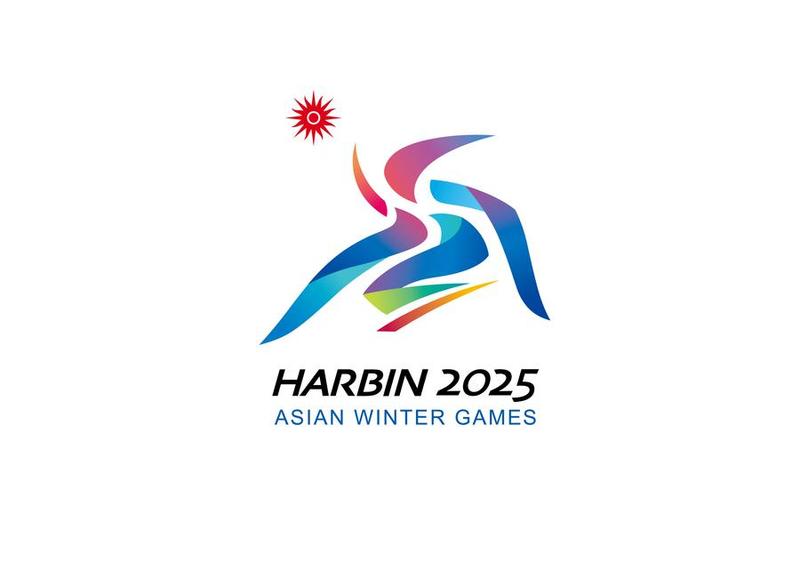
China has approved and registered 19 special symbols of the upcoming 9th Asian Winter Games, such as the emblem and mascots, in a move to strengthen intellectual property protection for the sports event, an official from the country's top IP regulator said.
"We've also set up a quick channel to review patent applications involving the event, and authorized six design patents already in this way," Guo Wen, head of the China National Intellectual Property Administration's IP protection division, told a news conference on Wednesday.
Harbin, the capital of Heilongjiang province, will host the games from Feb 7 to 14.
Guo revealed that a campaign to fight IP infringements involving the games has been launched since the end of last year and will end in the middle of February.
The combat of malicious trademark registrations has been intensified nationwide, she said, adding that the administration has guided major livestreaming and e-commerce platforms, including Douyin, Kuaishou, JD and Pinduoduo, to strengthen IP protection while selling the authorized products related to the games.
Additionally, greater efforts have been made in introducing copyright, trademark and patent policies and laws to public, she said, calling on all walks of life to raise the awareness of IP protection to ensure the smooth progress of the event.

The bustling Harbin Ice-Snow World, the world's largest ice-and-snow theme park, has welcomed more than 1 million visitors just 20 days after opening, setting a record high for the annual winter wonder that has delighted guests for 26 years.
Harbin, capital of northeast China's Heilongjiang, has emerged as one of the country's top winter travel destinations, attracting visitors from around the globe.
As the city's iconic landmark, the Harbin Ice-Snow World, with this year's edition, the largest in its history, boasts 1 million square meters, up from last year's 800,000 square meters. More than 300,000 cubic meters of ice and snow were used in its construction.
As of 10 pm Thursday, the park had received a total of 1.03 million visitors since it opened on Dec 21, 2024.

The park design incorporates elements inspired by the upcoming 2025 Harbin Asian Winter Games, set to open in February, as well as the upcoming Spring Festival, which will take place at the end of January.
In addition to the park's popular attractions, which include super ice slides, ice palaces and sculpture as well as various ice and snow fun sports, visitors are also drawn to the local cuisine. A particular fan favorite among tourists is the big hotpot, which features a mix of over 30 varieties of ingredients and offers a warm and satisfying dining experience.
According to statistics of Harbin Cultural and Tourism Bureau, from Nov 1, 2024 to January 7, 2025, the city received 18.6 percent more visitors than the same period last year with the surge of foreign tourists up by 41.1 percent year on year.
HARBIN -- As the 9th Asian Winter Games marks its 30-day countdown on Wednesday, the host city of Harbin is entering its final preparation stage, accompanied by growing enthusiasm.
"I have no doubt that the 9th Asian Winter Games in Harbin will be another great success in the history of the Olympic Movement in Asia," said Husain Al Musallam, director general of the Olympic Council of Asia (OCA).
Located in northeast China's Heilongjiang province, Harbin will host the Games for the second time, having previously hosted the event's third edition in 1996. According to the recently released competition schedule, ice hockey and curling events will begin earlier, on Feb 3 and 4, respectively, with the overall schedule spanning 12 days. The first gold medal event will take place on the morning of Feb 8.
Under the theme "Dream of Winter, Love Among Asia", the Games has so far received 1,275 athlete registrations (755 men and 520 women) from 34 countries and regions across Asia. This is expected to make it the edition with the highest number of participating countries, regions, and athletes.
To ensure a high-quality event, organizers have assembled numerous ice and snow professionals from both domestic and international backgrounds. International and Asian sports federations have appointed 12 technical delegates and one assistant technical delegate from countries and regions including China, South Korea, and Japan.
The OCA has appointed 151 international technical officials, who will work alongside 685 domestic officials, many of whom have extensive experience from the Beijing Winter Olympics and other major events.
Harbin has planned 14 test events since September 2024, covering all competition venues and events.
"The test events evaluated the operation of the venues, equipment and facilities, local support, command and coordination, as well as performance across various business areas," said Li Guang, director of the Sports Competition Department and deputy commander of the Competition Command Center for the Games.
"As we enter the final stretch, we will continue to make every effort to ensure that everything runs smoothly during the Asian Winter Games," Li added.
Test events for snow sports are also being conducted as scheduled in the Yabuli competition area.
"In addition to the 32 events of the Asian Winter Games hosted in Yabuli, we will also host over 20 professional and amateur competitions," said Wang Keshuai, deputy commander of the Command Center for the Yabuli competition area.
Wang noted that Yabuli is taking the opportunity to host more high-level ice and snow events, accelerate infrastructure upgrades, and diversify its offerings.
Compared to summer sports, winter sports are more vulnerable to weather conditions. To address this, meteorological departments in Heilongjiang province and Harbin have developed a comprehensive support plan that includes weather forecasting and monitoring networks.
More than 60 advanced automatic weather monitoring devices have been installed at key locations, including the opening and closing ceremony sites, competition venues, and along highways. These devices are part of a precise forecasting system designed to minimize weather-related disruptions.
In just 30 days, Harbin will welcome athletes from across Asia to pursue their dreams, while the world celebrates winter sports and the passion that drives them forward.
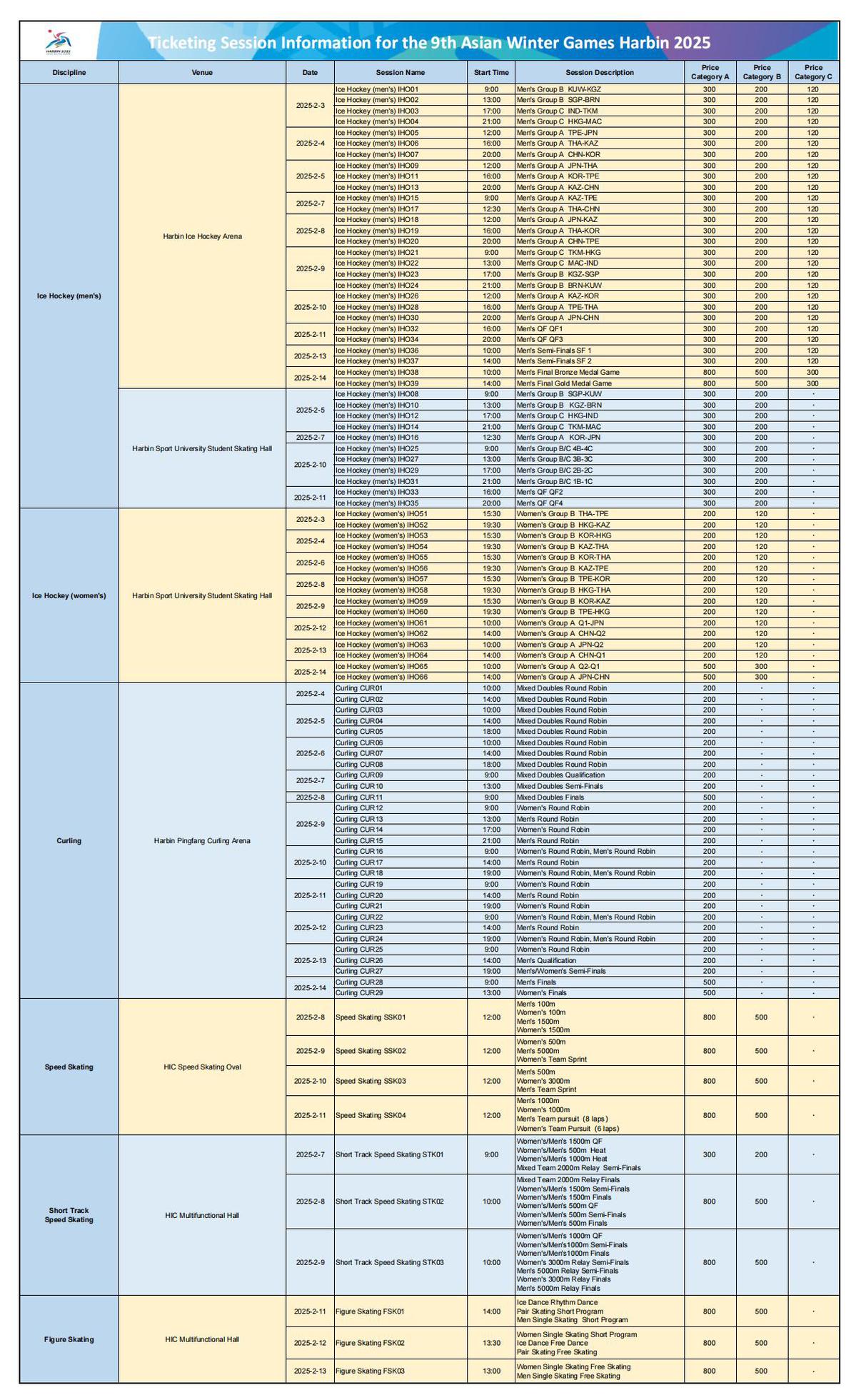
Ticket sales for the 9th Asian Winter Games Harbin 2025 will start on Jan 11, the organizing committee announced on Wednesday.
Harbin, the capital of Heilongjiang province, is confidently pushing ahead with the final preparations for hosting the Games, which will open on Feb 7.
Tickets for the games include all five ice sports — ice hockey, speed skating, short-track speed skating, figure skating and curling.
All the competition venues for the Games — five for ice sports in downtown Harbin and another eight for snow events in Yabuli — have completed renovation and equipment upgrading to meet international standards.
Despite limited seats, the executive committee is committed to bringing the experience to as many people as possible.
Tickets will be available on the official website of Harbin 2025 (https://www.harbin2025.com/), the official ticketing website (http://tickets.harbin2025.com/) and the official ticketing WeChat mini-program.

To welcome the upcoming 9th Asian Winter Games, the host city of Harbin is adorned with decorative elements that reflect the event's theme.
Billboards, wall murals and sculptures featuring the Games' mascots — Siberian tigers "Binbin "and "Nini" — can be seen throughout the city.
The lovable figures were created by a team from the Academy of Arts & Design at Tsinghua University, and symbolize an in-depth exploration and shaping of the unique natural and cultural heritage of the country's Northeast — Siberian tiger culture.
"The archetypes of Binbin and Nini are two cute little Siberian tigers born in September 2023 at the Siberian Tiger Park in Harbin," said Zhang Qixiang, mayor of Harbin and vice-chairman and secretary-general of the Organizing Committee for the 9th Asian Winter Games.
"We pondered what kind of mascots could encapsulate the rich history and contemporary flair of Harbin, along with the warmth, honesty and romance of its people. We then considered the Siberian tiger, with its three-million-year evolution. A symbol of nature's harmony in Heilongjiang, it embodies both power and playful charm," explained Chen Lei, the head of the mascots and emblem design team for the Games.
In Chinese culture, the tiger symbolizes good luck, and embodies qualities such as integrity, strength, and courage, all in line with the spirit of the continental sporting gala.
The Games' torch, which takes the form of a blossoming lilac, stands at a height of 735 millimeters, with a diameter at the crown of 115 mm and a grip diameter of 50 mm.
It features colors such as China red, lilac purple and snow white. The outer edge of the torch's combustion chamber is adorned with a cutout snowflake pattern.
When ignited, the torch presents a harmonious blend of ice and fire, highlighting the brilliance and passion of winter sports.
The torch design is further inspired by the Heilongjiang River that flows through Heilongjiang province.
Zhang Junhai, the designer of the torch and an industrial design teacher from University of Science and Technology Beijing, explained: "I designed the entire torch around the concept of the surging power of water, in a majestic and powerful manner. Therefore, the torch's shape grows upwards from the bottom."
The design theme — "surging" — aims to embody the lively and dynamic energy of nature, symbolizing that the 9th Asian Winter Games will be both vibrant and passionate.
The medal design for the Games, named "Spirit of Speed", combines the streamlined shape of a race track with the emblem of the Games on the front side, capturing the powerful and graceful motion of athletes in action. The flowing curves of the track incorporate the silhouette of the Harbin Grand Theater, reflecting the city's unique aesthetic.
The reverse side of the medal features a picturesque view of Yabuli, with mountain ranges and forests providing a vibrant portrayal of Heilongjiang's rich and bountiful landscape.
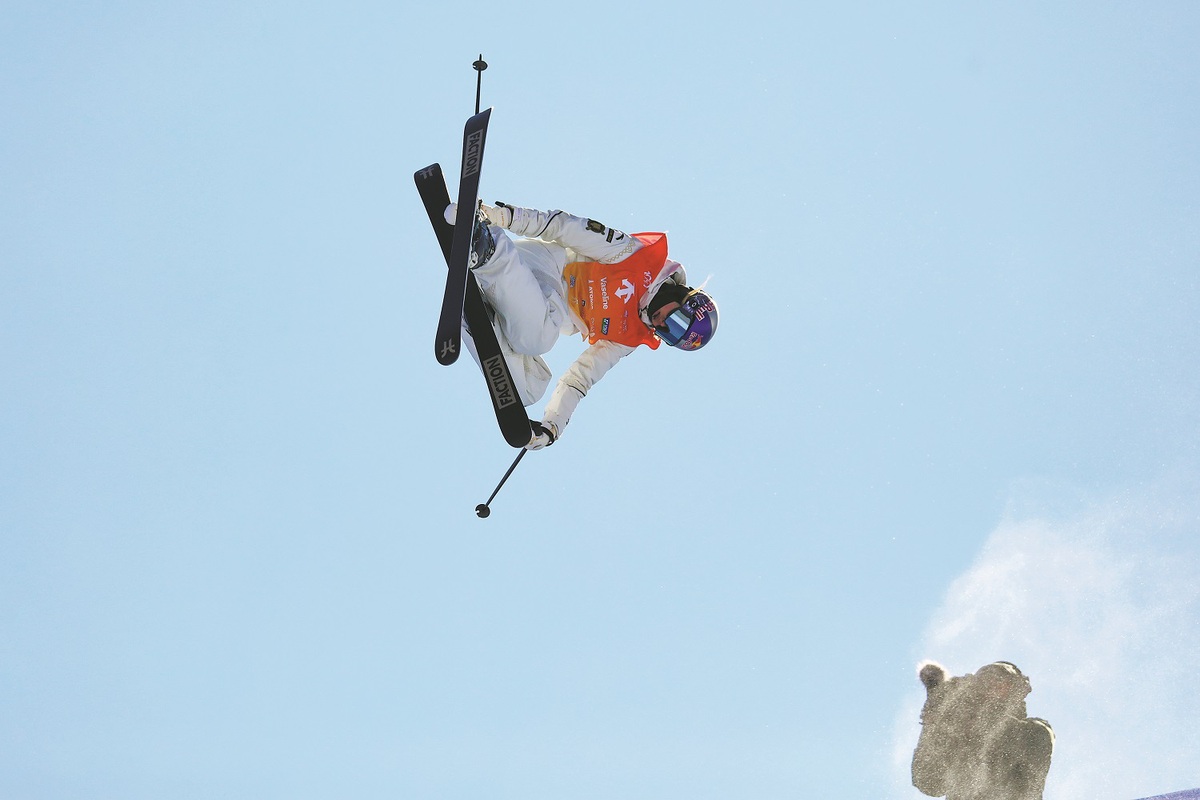
Led by a strong field of Olympic and world champions, China's ice and snow sports contingent is primed to do the country proud, while testing its Olympic medal credentials at the Asian Winter Games.
Fast approaching, and expected to be a "dress rehearsal" for the next Winter Olympics, the 9th Asian Winter Games will open in Harbin, capital of Heilongjiang province, on Feb 7. They are expected to bear witness to heated battles for continental supremacy on ice and snow, as Chinese athletes rev up their preparations for Milan-Cortina 2026.
The Games in Harbin will mark the biggest representation of Asian countries and regions, with 34 National Olympic Committees — the most in history — having confirmed their entries.
A total of 64 medal events across six sports will be competed at five ice sports venues in downtown Harbin, and eight other venues for all the snow events in Yabuli, a ski resort cluster about 200 kilometers to the southeast of the city.
Among the events making their debut on the continental gala's official medal program will be mixed doubles curling, ski mountaineering and the freestyle skiing discipline of synchronized aerials, according to the latest Olympic program for the 2026 Winter Games in Italy.
Leading the host's charge on ice will be its highly decorated short-track speed skating squad, which has contributed 12 Olympic gold medals to China's all-time haul of 22 since 1980, with the sport's other world powerhouse — the Republic of Korea — raring to spoil the host's party and deliver a fruitful campaign of its own.
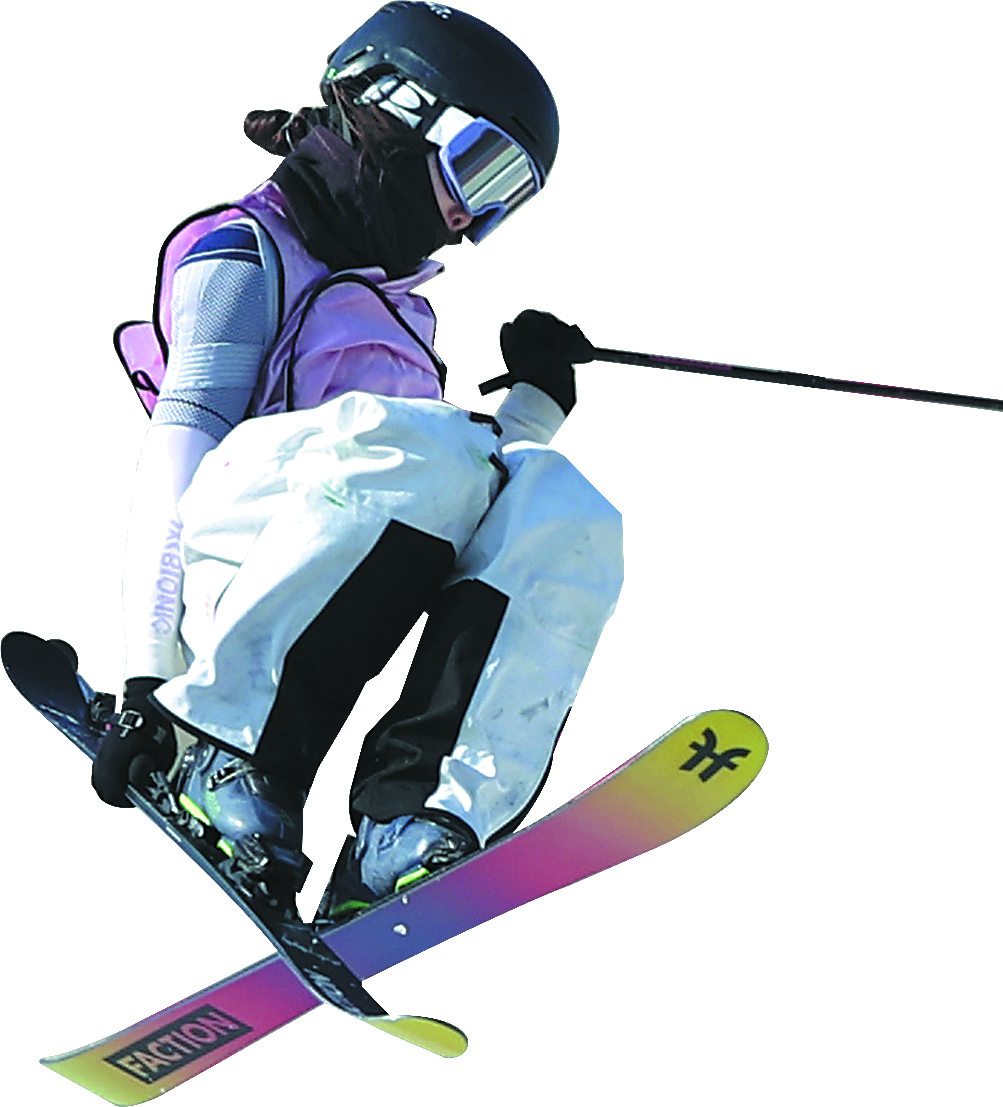
After completing the first four stops on the 2024-25 Short-Track World Tour, the Chinese squad — bolstered by men's Olympic gold medalists Liu Shaoang and Lin Xiaojun, and women's veteran Fan Kexin — has recovered physically and mentally from the demanding races on the ISU circuit, and is primed to help get the entire host delegation off to a scintillating start in Harbin.
According to the latest schedule, the first gold medal to be awarded at the Games is expected to be either in the short-track speed skating 2,000m mixed relay in Harbin, or in the women's freestyle skiing halfpipe in Yabuli on the morning of Feb 8.
"For short-track speed skating, the Asian Winter Games already represent the highest-level of international competition, even without other strong teams from Europe and North America," said head coach Zhang Jing, who, over the past two months, has led China's short-track squad to collect 10 medals, including three golds, from the first four legs of this season's World Tour.
"We will treat it as seriously as we should, and try to achieve the best possible results as a crucial test prior to the 2026 Winter Olympics."
Stealing the show from the skaters, should she keep her promise, will be freeski superstar Gu Ailing. She openly expressed her desire, following last month's World Cup event in China, to make time in her busy schedule of academic study and international competitions to make her Asian Winter Games debut on home snow.
"For sure, I will continue to compete at a series of international events and hope to see you all in February in Harbin," Gu said last month after winning the 2024-25 World Cup season's second halfpipe event, and her 16th career title on the elite circuit, in Chongli, Hebei province.
If Gu appears on top of the pipe in Yabuli as expected, with the official Chinese delegation yet to be announced, no one seems a legitimate threat against the reigning Olympic champion in her attempt to potentially claim the first gold at the Games.
Standing alongside Gu in aiming for a podium finish in freeski will be emerging contender Liu Mengting, who just won her first career World Cup title in another discipline — big air — in Klagenfurt, Austria, on Saturday, with the 20-year-old stomping two solid runs to edge out Italian star Flora Tabanelli and Germany's Muriel Mohr in the final.
"I'm so happy. My first World Cup win, it's so cool. I can't wait for more," said an elated Liu, who became China's second women's big air World Cup winner after Gu's victory in the 2020-21 season.
China will also bid for dominance in freestyle skiing aerials, its traditional strength event, with Olympic champions Xu Mengtao and her male counterpart Qi Guangpu both expected to star in Yabuli.
As a long-time world-class winter sports contender on the international stage, China's East Asian neighbor Japan is likely to flex its muscles in a variety of events, such as speed skating, figure skating and snowboarding, and offer Chinese hopefuls an invaluable opportunity to test their mettle against the world's best.
It will be Harbin's second time staging the continental gala event, following its maiden outing as host in 1996, and the third edition to be held in China after the 2007 Asian Winter Games in Changchun, Jilin province.
All the competition venues are existing facilities, and all the refurbishment and equipment upgrades needed to meet international standards were completed by the end of last year.

With mascots greeting visitors and competition venues prepared in optimal conditions, "Ice City" Harbin launched its one-month countdown to the 9th Asian Winter Games on Tuesday.
Already a popular tourism destination in Northeast China, the capital of Heilongjiang province is buzzing with more excitement this winter as it enters the homestretch of preparations for hosting the Games, which will open on Feb 7.
Relying on its abundant winter sports facilities and the rich experience gathered when hosting the event for the first time in 1996, the city is confidently pushing ahead with the final preparations, according to the organizing committee.
Harbin's encore as a host will help cement its status as an international sports hub and winter tourism wonderland for both domestic and overseas visitors, it said.
"I believe with all our efforts, the city will build an excellent stage for Asia's best winter sports athletes to demonstrate their talent and present ice and snow sports fans with an unforgettable treat," Li Guang, competition director of the Harbin 2025 Asian Winter Games Organizing Committee, said at a news conference on Tuesday.
The 2025 Harbin edition of the Games will mark the largest representation of Asian countries and regions, with 34 national Olympic committees — the most in the event's history — having confirmed their participation, including Cambodia and Saudi Arabia, which are taking part for the first time.
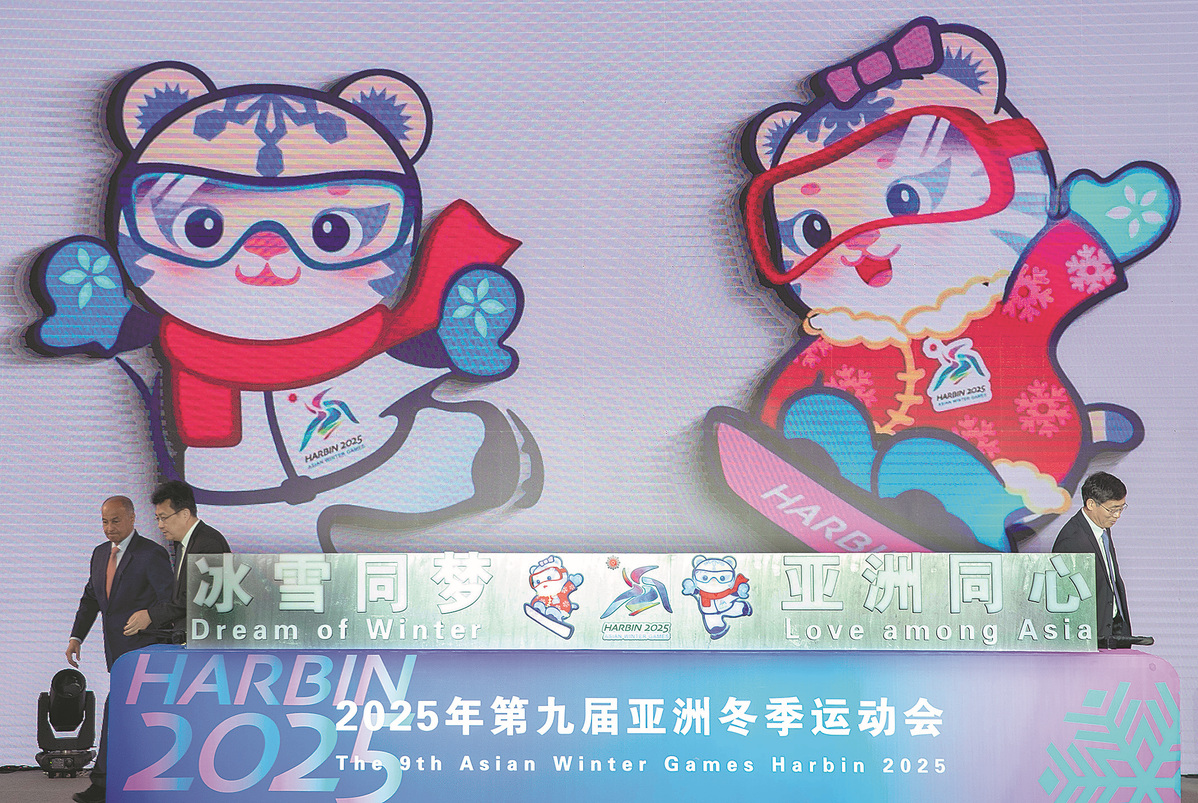
A total of 1,275 athletes have signed up to compete in 64 medal events across six sports through Feb 14, according to the organizing committee. Among the events, mixed doubles curling, ski mountaineering and synchronized freestyle skiing aerials will make their debut at the Games, it revealed.
All 13 pre-existing competition venues — five for ice sports in downtown Harbin and another eight for snow events in Yabuli, a ski resort cluster located 200 kilometers from the provincial capital — have completed renovation and equipment upgrading to meet international standards. The venues are currently fine-tuning services and operations based on feedback from seven test events held last year.
Seven more test events, all for snow-based sports, will continue examining facility readiness, staff training and service protocols at the venues over the next two weeks, in order to ensure "no stone is left unturned" to guarantee the best possible experience for all participants, said Li.
To address various challenges triggered by Harbin's cold weather, particularly those related to traffic during the Games, the city has mobilized over 40,000 sanitation workers, deployed 1,700 sets of cleaning machinery and prepared over 4,000 metric tons of eco-friendly snow-melting agent, according to the city's urban management bureau.
The primary objective is to keep main roads and transport hubs near the competition venues clean and dry even if there is heavy snowfall, said the bureau.
Tang Kexin, head of the bureau, said: "We've done three rounds of snow-removing drills so far this winter, with the efficiency of the staff very much improved. We will pile up excess snow in some areas though to keep the city's winter characteristics within the reach of visitors."
The organizing committee also announced on Tuesday that the highly anticipated opening ceremony of the Games has been rehearsed under the guidance of Chief Director Sha Xiaolan, who was the architect of the well-regarded opening and closing ceremonies of the Hangzhou Asian Games in 2023.
The opening ceremony will take place at the Main Media Center.
"Since November, the rehearsals have been running at multiple locations simultaneously. We are confident that the opening show will demonstrate the Chinese spirit in the new era, while extending our sincere wishes to build a harmonious Asian community with a shared future," said Du Wenxi, operation director of the Main Media Center.
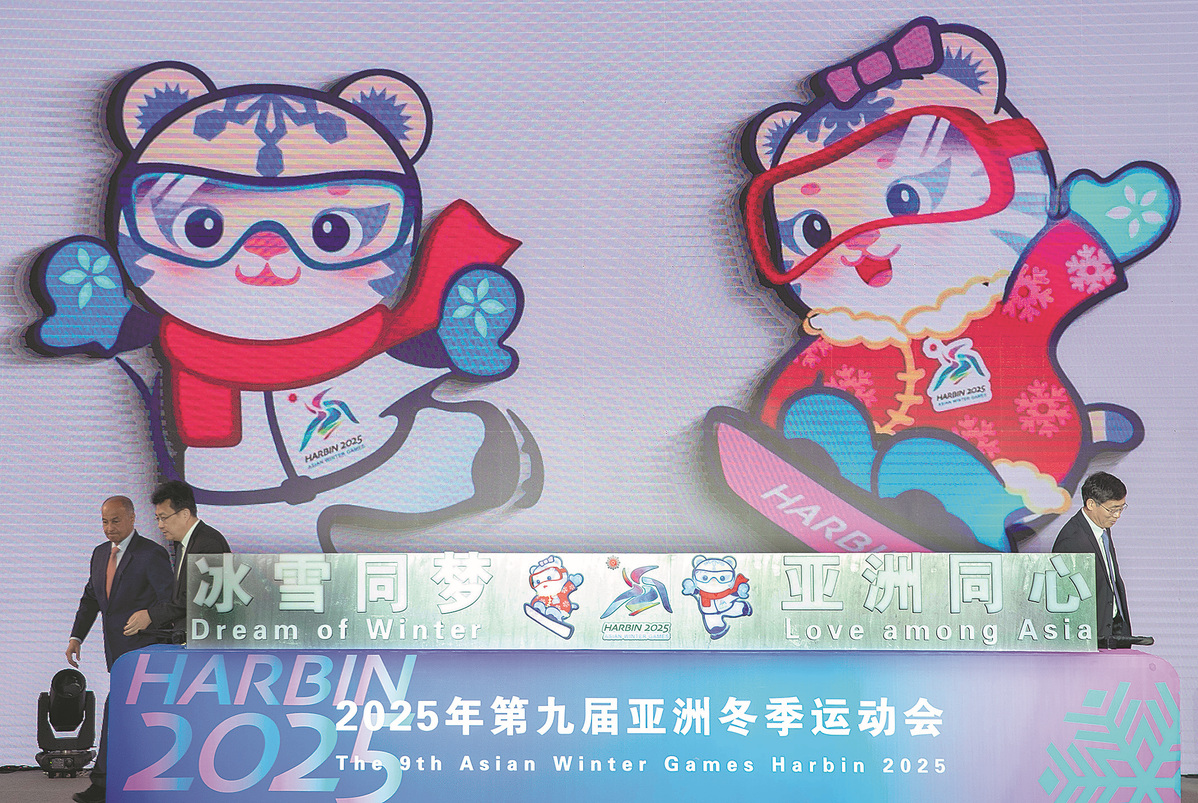
With half of the test events completed and all preparatory work advancing smoothly according to schedule, Harbin, the capital of Heilongjiang province, is primed to host the 9th Asian Winter Games in less than 50 days.
Known as an ice and snow wonderland in Northeast China, the city is buzzing with fresh excitement this year, with posters, mascots and countdown timers reminding residents and visitors of the return to Harbin of the continental winter sports gala after nearly three decades.
Harbin, which previously hosted the Games in 1996, will welcome Asia's best ice and snow sports talent from a record number of 34 National Olympic Committees to compete in 64 medal events from Feb 7 to 14, and organizers are beefing up efforts to promote winter sports participation and tourism in the region.
Seven of the 14 planned test events for the Games have been completed according to international standards, covering sports such as speed skating, figure skating, ice hockey and alpine skiing, as organizers continue to run security checks, emergency drills and staff training programs at all competition and noncompetition venues.
The competitions will be held at five ice sport venues in downtown Harbin and another eight venues for snow sports in Yabuli, a ski resort located about 200 kilometers from the provincial capital. All these venues are existing facilities and require only renovation and equipment upgrades to meet specified technical standards.
The two hosting areas are connected by a high-speed railway line, and the traveling time is only 50 minutes. The refurbishing of railway stations, streamlining of transportation hubs, and planning of shuttle services for athletes and accredited media staff have been completed, while a newly built second runway at Harbin's international airport will open on Jan 24, according to the organizing committee.
Thirty-one hospitals have been designated as medical service providers for the Games, while 550 medical personnel have been trained and deployed across all venues for administering first aid.
A total of over 700 dishes will be on the menus at official Games hotels to cater to the taste buds of international athletes and officials.
"With venue preparations progressing well and test events on track, we have shifted to the Games operation mode from the planning stage. We are confident that the Games will be a resounding success," Bai Zhiguo, a deputy secretary-general of the Games' organizing committee, said at a news conference on Monday.
Harbin's readiness and the committee's organizational expertise have impressed the Olympic Council of Asia.
"China has rich experience of organizing multisport events, and Harbin has seized international attention and praise for its professional and efficient preparatory work for the Games," said OCA President Raja Randhir Singh.

China Eastern Airlines unveiled on Saturday its second themed aircraft for the upcoming 2025 Harbin Asian Winter Games, which is scheduled to start in Harbin, capital of China's northernmost Heilongjiang province, on Feb 7, 2025.
The themed jet, which is an A330 wide-body jetliner, made its debut flight on Saturday from Haikou Meilan International Airport to Shanghai Pudong International Airport, according to the Shanghai-based carrier.

The first themed jet debuted on Oct 30, when the 100-day countdown to the Asian Winter Games was celebrated. As of Nov 14, it had conducted 49 flights for more than 6,600 passenger trips.
Compared to the first themed aircraft, the second one is bigger and capable of conducting flights of further distance with better traveling experience.
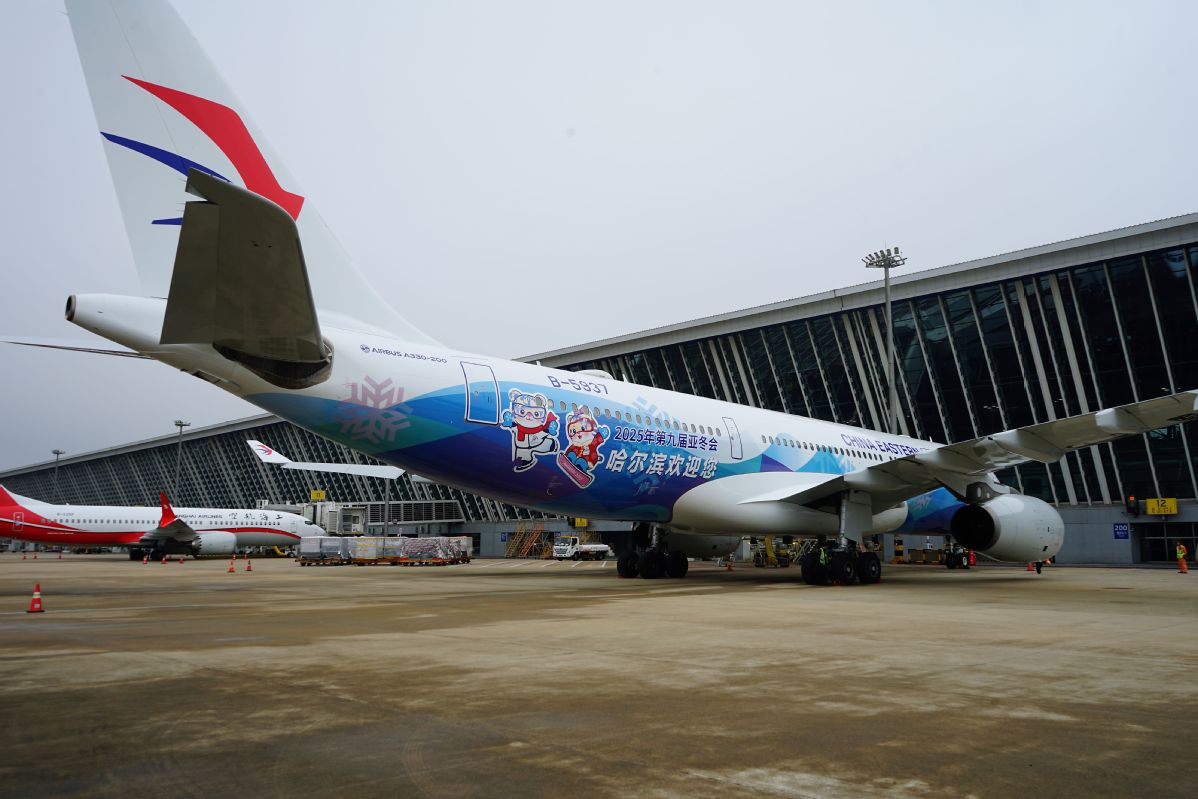
The outside is painted with various elements of the Asian Winter Games, including images of the event's mascots Siberian tigers "Binbin" and "Nini", and the interior of the jet's cabin is decorated with wintry motif-like ice and snow in its tray tables and overhead bins, apart from elements of the Asian Winter Games.

Winter tourism in Harbin, capital of Northeast China's Heilongjiang province, has begun to heat up.
Since early October, searches and bookings for Harbin winter tourism products on various online travel, group-buying and social media platforms have been steadily increasing, more so than during the same period last year, according to a recent Harbin Daily report.
Data from major online services platform Meituan shows that searches for winter activities such as skiing, ice fishing, snow hiking, and aurora and rime viewing in areas around China have increased by 72 percent. Among them, Harbin has the highest search volume, with attractions such as Harbin Ice and Snow World, Harbin Ice Wonderland and the Yabuli Ski Resort dominating interest.
Hotels and guesthouses in Harbin have already begun preparing for guests to ensure they have a comfortable, enjoyable experience.
Data from the Harbin Market Supervision Bureau shows that in the first nine months of this year, the number of accommodation providers in the city has increased 198 percent year-on-year.
"Two new hotels located in the north of the Songhua River in Songbei district will open in early November," said Zhang Xinyu, the person in charge of Bochen Chain Hotels. "We have three hotels in the south of the river, and the two new ones are expected to provide our customers with a beautiful view of the Songhua River outside their windows during their stay."
As Harbin is gearing up to host the 9th Asian Winter Games in 2025, Harbin Madieer Group Co is fully leveraging its strengths to provide high-standard service guarantees to tourists across the world, according to the company.
For instance, its Modern Hotel, which is located on Central Avenue, is undergoing renovations and is upgrading its guest rooms to welcome the arrival of the Asian Winter Games and the ice and snow season.
"We have been receiving many phone inquiries recently regarding room booking," said Zhang Jinying, manager of the group's brand promotion department.
"To build a more optimal environment for our customers, we will continue to provide personalized services, such as prioritizing check-in for elderly guests to reduce their waiting time and offering children's books and toys, as well as children's toothbrushes, slippers and baby supplies for families traveling with children to enhance their travel experience.
"For female customers, we have prepared makeup storage boxes, hand jewelry storage bags, waterproof pads, brown sugar water and disposable face towels to enhance their comfort," said Zhang, adding that English explanations about the hotel's history and culture will be provided for foreign tourists.
Despite its name, Modern Hotel boasts a history of over 100 years.
Among the city's scenic spots, Harbin Ice and Snow World, which was recognized in January by Guinness World Records as the world's largest ice and snow park, is the most popular. This winter season, it will be expanded from 810,000 square meters to 1 million sq m.
After 25 consecutive years of operation, the 26th Harbin Ice and Snow World will fully integrate Asian Winter Games elements to create a more dazzling park combining ice, snow, sound and lights.
Liu Yuanqi, an English teacher in Hangzhou, Zhejiang province, said she is already looking forward to the winter holiday and is paying attention to the ticket sales information of the Winter Games.
"During last year's Hangzhou Asian Games, I watched several matches in my city," she said. "This winter, I hope to visit Harbin to enjoy ice and snow, as well as the unique charm of ice and snow sports."

HARBIN -- The landmark ice-and-snow theme park in Harbin, capital of Northeast China's Heilongjiang province, will expand ahead of the ninth Asian Winter Games, said local authorities.
The Ice-Snow World, built on the northern bank of the Songhua River which flows through the city, will cover a million square meters in the coming snow season, up from 810,000 square meters in the last season. With its size equivalent to 140 football pitches, the extravaganza during the upcoming snow season will be of the largest scale.
A total of 300,000 cubic meters of ice and snow will be used for crafting sculptures such as castles and towers, up from 250,000 cubic meters. Design and construction of the park will feature elements of the ninth Asian Winter Games.
The theme park grew from the former Harbin Ice Lantern Festival, which started in 1963. In December 1999, the Ice-Snow World was built in Harbin to mark the millennium. This season will mark its 26th anniversary, with the park scheduled to open in mid-December.
The ninth Asian Winter Games in Harbin, scheduled for February 7-14, 2025, will see record participation. More than 1,500 athletes from 34 countries and regions have registered so far.

People gathered at the Harbin Ice Hockey Arena in Harbin, Heilongjiang province, on Wednesday evening to celebrate the 100-day countdown to the 9th Asian Winter Games, which will kick off on Feb 7 next year.
The revelation of the gold, silver, and bronze medals, alongside the torch and the Games' theme song, sparked a wave of cheers from the attendees at the event.

Harbin 2025 will be the pinnacle of winter sports events in Asia, said Raja Randhir Singh, President of the Olympics Council of Asia, via a short video at the ceremony.
"Harbin will become the second city to have hosted two editions of the Asian Winter Games, which will be a significant honor for the city and a brilliant milestone in the history of the Asian Winter Games," he said.
"China has rich experience in hosting major sports events, and Harbin has demonstrated professionalism, efficiency, and outstanding work preparing for the Asian Winter Games," he added.

Singh stated that Harbin 2025 would welcome the highest number of participating countries, regions, and athletes in the history of the Asian Winter Games, adding that he had complete confidence that Harbin would host a splendid event.
The 2025 Harbin Asian Winter Games will feature the largest representation of Asian countries and regions to date, with 34 National Olympic Committees, including newcomers Cambodia and Saudi Arabia, confirming their entries. The event is expected to host over 1,500 athletes.



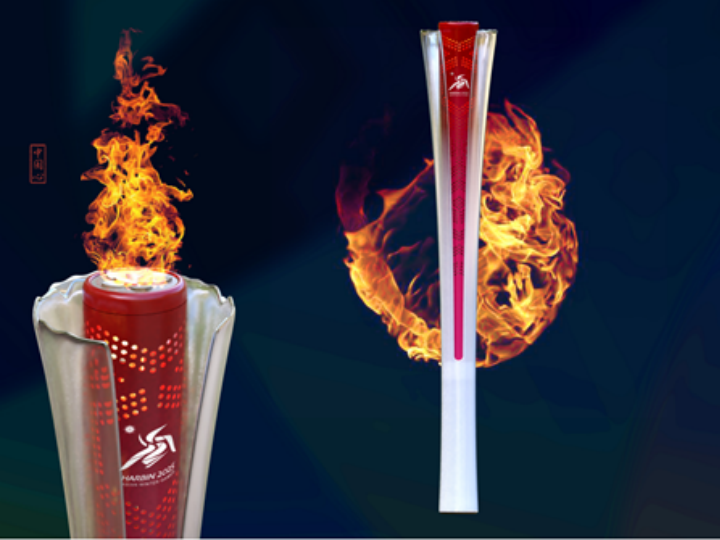
HARBIN - The torch, medals and anthem for the 2025 Asian Winter Games in Harbin were officially unveiled on Wednesday.
The height of the torch is 735mm, with a top diameter of 115mm and a grip diameter of 50mm. The theme of the design, "Surging", aims to capture the vibrant and dynamic energy of life in nature. It symbolizes that the 9th Asian Winter Games will be filled with vitality and passion. The overall torch design incorporates international aesthetic features while blending classical and modern Chinese art.
The design takes the form of a blossoming lilac, integrating colors such as China Red, Lilac Purple, and Snow White, symbolizing the sincerity, warmth, openness, and inclusivity of Heilongjiang Province and the characteristics of the host city, Harbin.
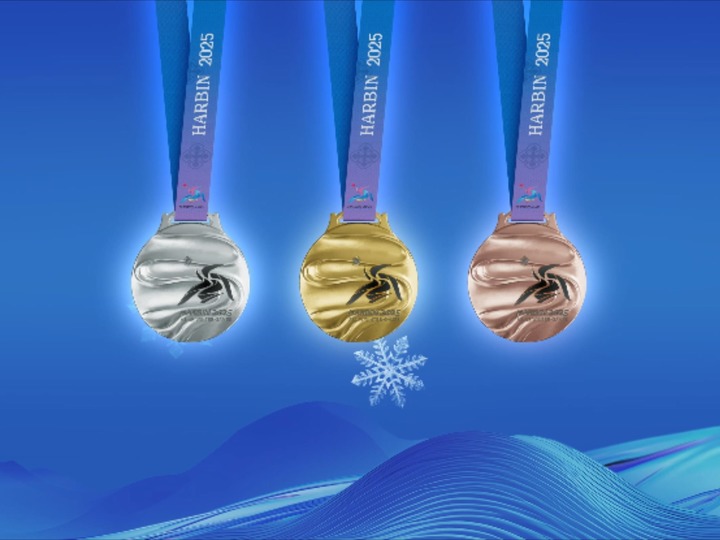
The torch features a burner nozzle that combines a lilac floral design with a hollow center, creating a three-dimensional effect. The outer wall of the upper combustion chamber is designed with hollow snowflakes, harmonizing the beauty of order with the overall biomimetic natural aesthetic, blending culture and technology with natural artistry. The outer shell resembles a blossomed lilac, transitioning from transparent ice crystal to Snow White. The inner core transitions from China Red to Lilac Purple. When lit, the torch presents an effect of ice and fire merging, highlighting the radiant energy of winter sports that springs from challenge and passion.
The medals for the Asian Winter Games, titled "Spirit of Speed", was also released on the same day. The front of the medals combines the streamlined shape of a racetrack with the emblem of the 9th Asian Winter Games, capturing the powerful and graceful motion of athletes in action. This design embodies the strength and beauty of competitive sports. The flowing curves of the racetrack incorporate the silhouette of the Harbin Grand Theatre, reflecting the city's unique aesthetic.
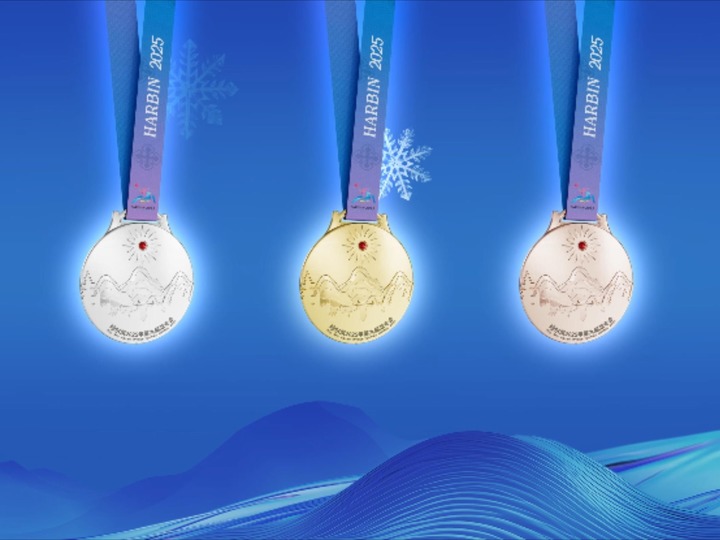
The reverse side of the medal features a picturesque landscape of Yabuli, with mountain ranges and forests that mirror the terrain of the Greater and Lesser Khingan ranges, creating a vibrant portrayal of Heilongjiang's rich and bountiful landscape. At the center, the emblem of the Olympic Council of Asia is embedded with a rare Xunke red agate gem from Heilongjiang -- symbolizing the sun shining brightly over the vibrant land. The ribbon clasp at the top of the medal is inspired by the Sun Gate of Sun Island Scenic Area, adding a distinctive local character to the design.
The anthem for the Asian Winter Games is titled "Snow of Harbin", written by lyricist and director Wang Pingjiu and composed by renowned domestic music producer Chang Shilei. The lyrics and melody express the vision of unity, friendship, and a shared commitment to peace and development among the people of Asian countries and regions, working together to build a community with a shared future for mankind.
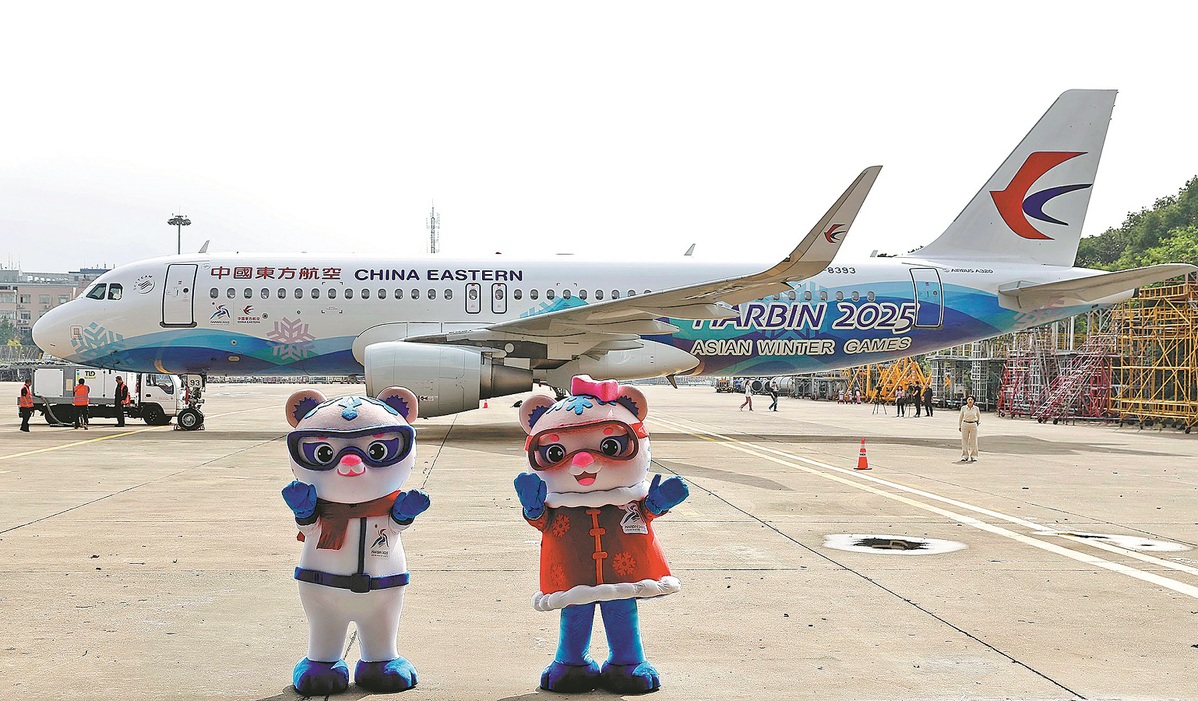
With venues ready, volunteers recruited and testing events underway, Harbin is nearly ready to take up its hosting duties for the 9th Asian Winter Games, with preparatory work almost done entering the 100-day countdown.
As a traditional hot spot for ice and snow sports activities in Northeast China, Harbin, capital of Heilongjiang province, is pushing ahead with preparations for the 2025 edition of the Games, with full confidence that the continental gala event will be a resounding success in promoting sports and culture exchanges in the region.
With 100 days to go before the Feb 7 opening ceremony, all 13 existing competition venues for the Games — five for ice sports in downtown Harbin and another eight for snow events in Yabuli, a ski resort cluster 200 kilometers from Harbin — have been renovated and have updated equipment to meet international standards, with workers trained and ready to be deployed to each site, according to the organizing committee.
The national men's and under-18 women's ice hockey championships, which were held during the National Day holiday, were the first of 14 test events to be held in Harbin through January to optimize various venue operations, including capacity, facility function and spectator services.
Over 6,000 volunteers, mostly local college students, have been recruited from over 10,000 applicants, with a quarter of them having experience serving at international events such as the 2022 Beijing Winter Olympics and last year's Hangzhou Asian Games, according to organizers.
The 2025 Harbin Asian Winter Games will mark the biggest representation of Asian countries and regions, with 34 National Olympic Committees — the most in the event's history — having confirmed their entries, including first-timers Cambodia and Saudi Arabia. Over 1,500 athletes are expected to participate.
A total of 64 medal events across six sports will be held from Feb 7 to 14. Among them, mixed doubles curling, ski mountaineering and synchronized aerials of freestyle skiing will make their debut at the Games.
Meanwhile, many Southeast Asian countries and regions, including Thailand, Malaysia and Singapore, have signed up for the alpine skiing competition, which will have more participants than any other event in Harbin's program, underlining winter sports' expanding landscape on the continent.
It will be Harbin's second time staging the continental gala since it hosted in 1996, and the third edition to be held in China after the 2007 edition in Changchun, Jilin province.
Boasting ready-made facilities and abundant experience in winter sports promotion, Harbin is confident it can deliver a memorable edition of the Games with strong Chinese characteristics and Asian style, organizers said.
"With full support from the government, the public and all shareholders, we've moved into the home stretch of preparations," Han Shengjian, vice-governor of Heilongjiang and vice-president of the Harbin organizing committee, said during a news conference on Tuesday. "We are committed to hosting a world-class event representing Asian spirit and Chinese style to promote winter sports across Asia, as well as the unique charm of Harbin as a generous host."
Already a popular winter holiday destination in the country, Harbin is keen on taking advantage of the Games to make the city more appealing to winter sports fans and foreign tourists, according to Wang Hesheng, mayor of Harbin and secretary-general of the organizing committee.
To help boost tourism in the city, a new metro line will be launched at the end of this month in Harbin, and a newly built second runway at the city's airport will open in January. In addition, more frequent high-speed railway services connecting mountain resorts in Yabuli with downtown Harbin and other major cities are coming in the near future.
"Hopefully after hosting the Games, Harbin will make its name as a winter wonderland more prominent, not just in our country, but also across Asia," Wang said.

With venues almost completed and testing events underway, Harbin has stepped up a gear in its final preparation for hosting an excellent Asian Winter Games next year to promote ice and snow sports in the region.
With preparatory work approaching the final 100-day countdown, organizers in Harbin, capital of Heilongjiang province, are busy putting the finishing touches to venues, testing facilities while running operational drills as excitement builds in Northeast China in anticipation of welcoming more than 2,000 athletes from a record number of 34 National Olympic Committees to the continental sports gala in February.
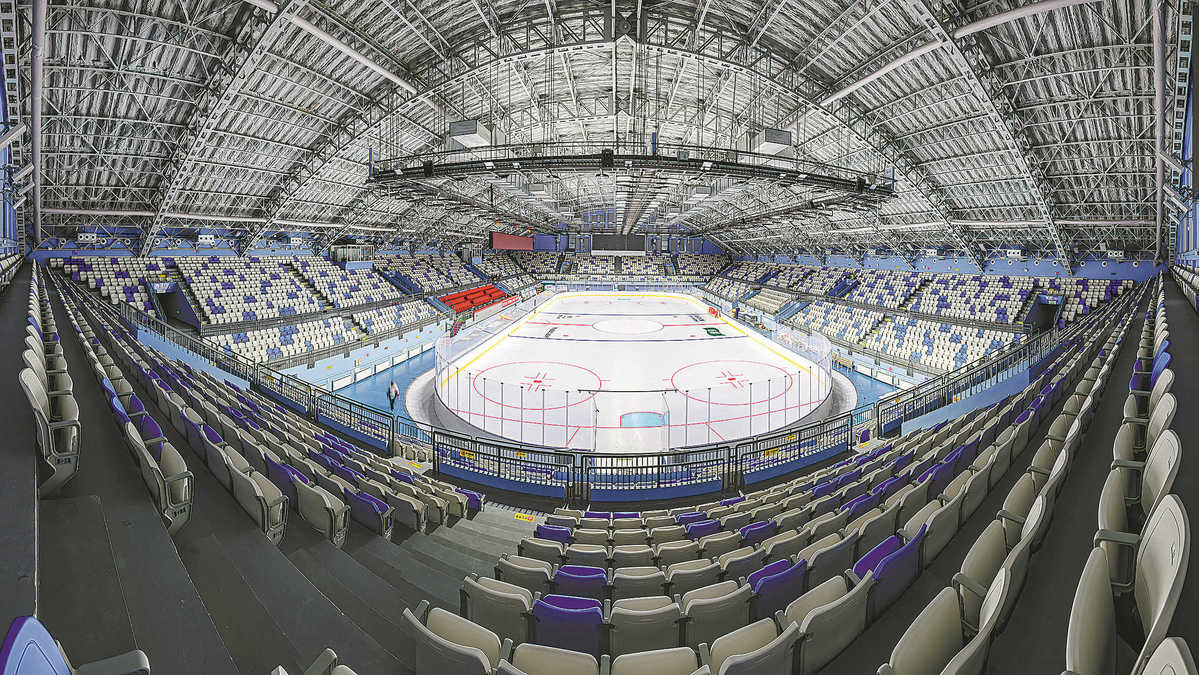
All the competition venues for the Games — five for ice sports in downtown Harbin and another eight for snow events in Yabuli, a ski resort cluster about 200km from Harbin — are existing facilities, and all the refurbishment and equipment upgrades needed to meet international standards will be completed by the end of this month, according to Chinese organizers.
As the first main venue ready for competition since early August, the Harbin Ice Hockey Arena has hosted a series of testing events, such as the national men's championship and a club tournament of four teams from the Shanghai Cooperation Organization member countries, over the past month. This provided a needed opportunity to test air conditioning, refrigeration, ice-making, as well the scoring and statistics display among other key functions all of which were put through their paces in real-time operation.
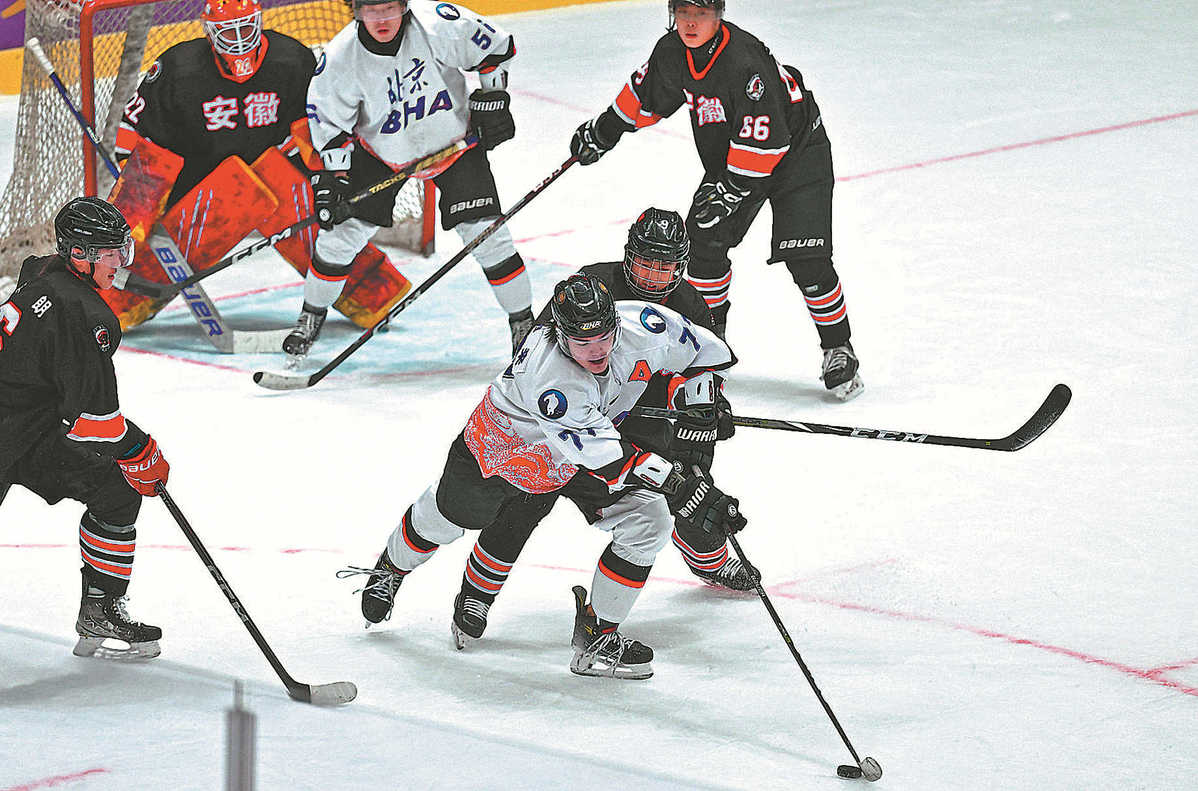
The original ice rink in the arena has also been downsized to a smaller surface, according to the new Olympic Council of Asia standards, to speed up the game and encourage greater physical contact to make it more entertaining to watch.
The arena's expanded 5,500-seat spectator tribune, air-conditioned to a comfortable temperature of around 15 C, about 25 degrees higher than the ice surface maintained at — 10 C, will guarantee a pleasant experience for fans from home and abroad.
"Everything and everyone involved in running a game here have been tested and examined. The venue operational team has also built some nice chemistry through the drills, which is quite important for smooth operation during the Games' time," said Li Yutian, a deputy competition director with the Chinese Ice Hockey Association.

Ready already
The 2025 Harbin Asian Winter Games will mark the biggest representation of Asian countries and regions with 34 NOCs, the most in history, having confirmed their entries.
A total of 64 medal events across six sports will be competed for from Feb 7-14. Making their debut at the event will be mixed doubles curling, ski mountaineering and synchronized aerials of freestyle skiing.
It will be Harbin's second time staging the continental gala event following its maiden hosting in 1996, and the third edition to be held in China after the 2007 edition in Changchun, Jilin province.
The next major test, among a total of 14 events to be held through January, will be a four-day short-track speed skating national tournament that kicks off on Nov 14. This is expected to involve 180 athletes in 30 teams at the Heilongjiang provincial ice sports training center.
A critical transformation rehearsal will follow the short-track tournament at the same rink to test the procedure of the facility switch for short-track to figure skating events at the same venue.
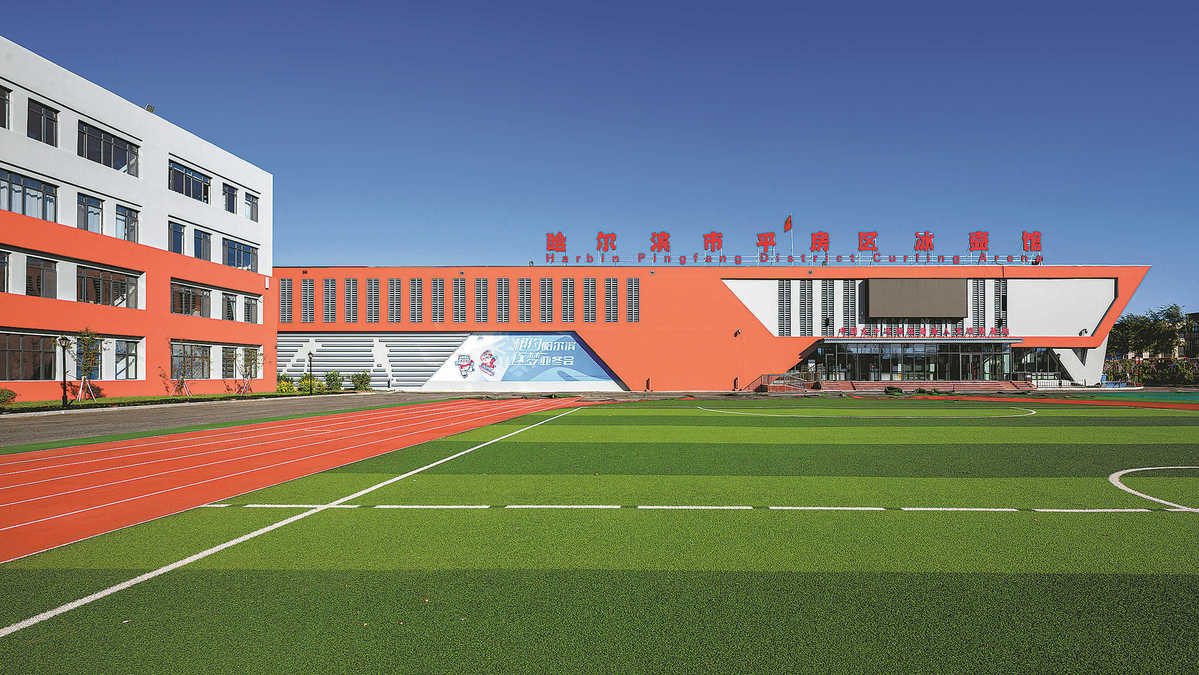
Boasting ready-made facilities and an efficient operational plan, Harbin is confident it can deliver a sustainable and memorable edition of the Games with strong Chinese characteristics and Asian style, said organizers.
"Our preparatory work has entered the final stretch of pre-Games testing and operation. Everything is processing well and on track. We are committed to hosting a world-class event representing Asian spirit and Chinese style to promote the unique charm of winter sports," Yu Hongtao, Harbin's Party chief and a vice-president of the organizing committee, said during a chef de mission seminar last month.
Officials and representatives of the OCA and 32 NOCs took part in the assembly of chefs de mission — team managers of participating delegations, and none of them left disappointed.
The Chinese host's readiness achieved on a tighter-than-normal schedule and organizational expertise have impressed delegation chiefs.
"They have the knowledge, the wherewithal and the government support. And they have the experience from the Beijing Winter Olympics in 2022 and also the Hangzhou Asian Games last year, which have brought a lot of expertise in organizing international sporting events in China. So I'm sure we will see a very high-standard Games here in Harbin," said Vinod Kumar Tiwari, the deputy director general of OCA.
Due to the pandemic-enforced delays on the bidding procedure, Harbin was only confirmed host of the 2025 edition by the OCA one year ago, on a much shorter notice compared to previous hosts that were decided at least five years in advance.
As the host of the following 2029 edition of the Asian Winter Games, Saudi Arabia sent its chef de mission Ahmed Bin Dhuwayhi to the seminar, hoping to learn from Harbin's best practices to promote ice and snow sports in his own country for the first major winter sports event to be held in the western Asian region.
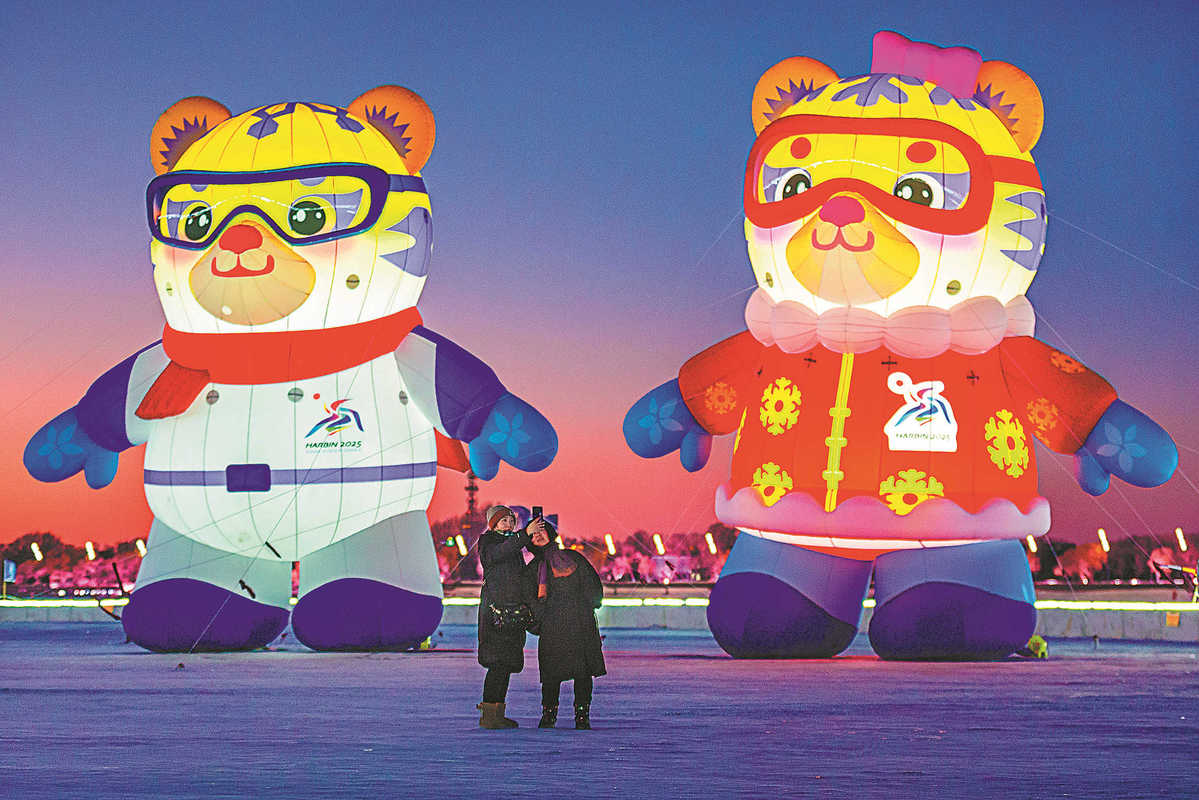
He wasn't disappointed at all.
"Since we are hosting the next event at the Trojena mountain destination, we will learn a lot from China. We know it's a big challenge to be better than China, but we are trying our best to host the best games we could," he said.
After a visit to the Yabuli resort area following last month's seminar, Ganesan Sundaram Moorthy, the manager of OCA's sports department, said he cannot wait for the Games to open.
"The venue is impressive. I can't wait for it to snow and then we will know how beautiful this place is," Moorthy said of the competition slopes at Yabuli.
"Hopefully, some world records can be broken here (during the Games). And the quality of this place will be better than some other championships around the world. I guess this could host the Olympic Winter Games as well."
Zhou Huiying contributed to this story.
sunxiaochen@chinadaily.com.cn
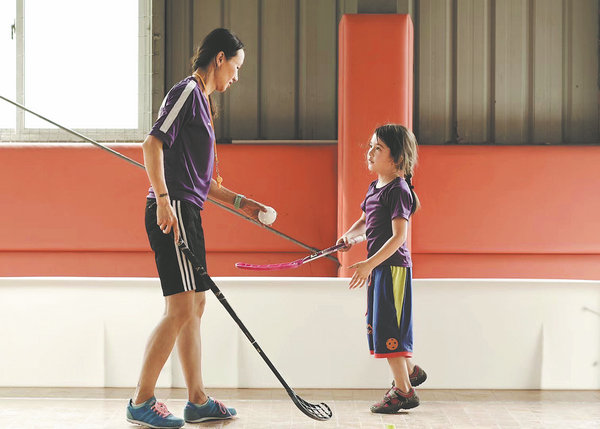
The Asian Winter Games in Harbin, capital of Northeast China's Heilongjiang province, may seem a distant prospect as most parts of China are basking in sunshine and rising temperatures. A far cry from the chilly blasts of winter, however, even in this climate, an "alternative ice sports" from Europe is gaining popularity.
The story has an unlikely beginning in 2002 when physical education teacher Chen Xin, then 27, stepped into a Swedish sports club in Shanghai.
The Shanghai International Studies University teacher had felt there was a significant decline in students' enthusiasm for sports and wanted to find out about activities that might appeal to young people.
At the club, Chen witnessed a spirited game — amid towering Swedish athletes, a petite girl held her own, moving about her competitors with fervor and determination and using her small stature swiftly and effectively in defense and offense.
It was Chen's first encounter with floorball, and she found it exhilarating, engaging and, more importantly, safe and easy to grasp.
"That's the sport I'd been searching for," Chen recalls.
Floorball, also known as indoor bandy, is a type of floor hockey with each team consisting of five players and a goalkeeper wielding sticks with plastic netting in place of blades. The ball is also plastic and has holes.
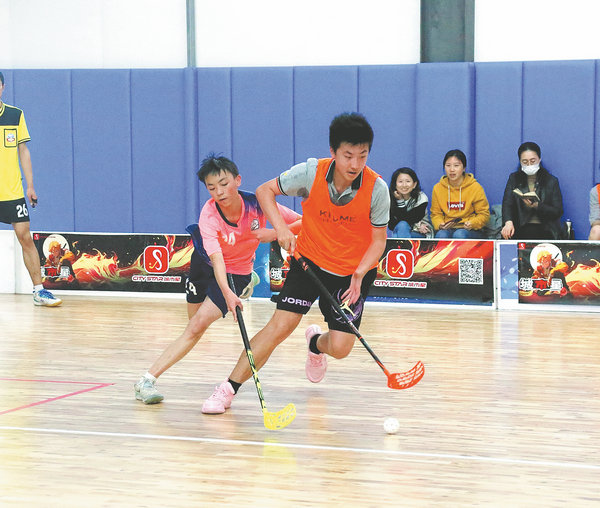
The game was invented in Sweden in the late 1960s and quickly became popular for its minimal equipment and space. By the 1970s, formalized rules were established, signaling the advent of floorball as a competitive sport, increasing its play across the world.
On top of a growing number of fans like sports teacher Chen, floorball is also offering a way for many athletes to focus on an activity that can allow them to train during the spring and summer seasons.
Compared to hockey, floorball is designed to be safer with its lightweight sticks made primarily of carbon material together with hollow plastic balls perforated with holes to reduce injury risks.
The sport requires speed, agility and teamwork.
Convinced of its potential, Chen resolved to introduce and popularize it within the university. The first step was to garner interest among her students.
"Since no one knew about this sport, I wanted to draw students in by associating it with something more familiar. This sport bears similarities to ice hockey, but without skates," Chen says.
"Thus, 'land-based ice hockey' (handi bingqiu) became its name in China."
In February 2018, China unveiled the Olympic Education Program for Primary and Secondary Schools in preparation for the Beijing 2022 Winter Olympics and Paralympics, including plans to introduce nonice variations of winter sports in select southern cities. The move aims to cultivate youth interest in winter sports and facilitate a gradual transition to traditional ice-based activities.
In February 2019, floorball was officially recognized as one of the promotional projects for winter sports leading up to the 2022 Beijing Winter Olympics by the General Administration of Sport of China.

Lifelong pursuit
With a swift swing, the ball sailed through the air in a graceful arc toward the goal. The goalkeeper sprang into action, successfully deflecting the ball. As the final whistle blew, cheers erupted and players embraced in triumphant celebration.
This marked the inaugural trial game at the Shanghai International Studies University campus in 2008, orchestrated by Chen. Gathering about 200 female students, she aimed to ignite their interest in floorball through direct involvement. As the match concluded, the passion of the competition reverberated through the arena, moving spectators to tears, including Chen herself.
As a pioneer of floorball promotion in China, Chen embarked on a journey from scratch in 2002. Initiating partnerships with sports equipment suppliers, she also extended invitations to foreigners in Shanghai to join floorball games.
"I hosted barbecue dinners with beers for them after their matches on our campus. Their participation progressively enriched the floorball community here," she says.
Years of dedication began to bear fruit in 2008 when Chen secured a sponsorship deal with a Swedish company in Gothenburg, providing necessary gear for students in five universities in China.
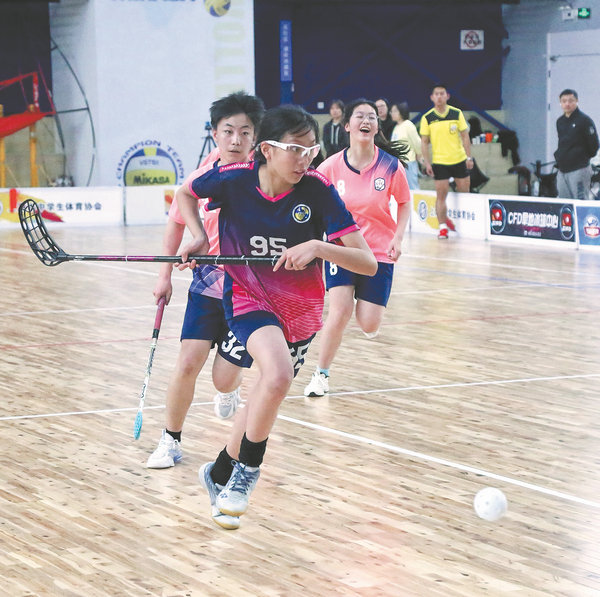
In a pivotal development in September 2008, floorball became an elective course in physical education at the Shanghai International Studies University and Chen encouraged more students to try the sport.
"The game was a resounding success. It showcased strong team spirit and a vibrant atmosphere of unity," she says.
From the first game in 2008 at the university, floorball has gained popularity in Shanghai, culminating in a university floorball group venturing abroad to Singapore in 2014 for the 6th World University Championships for Floorball.
"It's a pity that university players often lose interest in floorball after graduation," Chen says. "I believe health is as important as academic and career achievements. My mission is to engage more people in sports activities and empower them for healthy growth, which is my lifelong commitment."
On the ground
In 2013, driven by the desire to instill a lifelong love for sports in the younger generation, Chen established the China Floorball Development Center. The same year, armed with 20 floorball sticks sponsored by a Shanghai nonprofit group, she began on a journey to the Bangzhai Primary School, nestled amid the mountains in Qingzhen of Southwest China's Guizhou province.
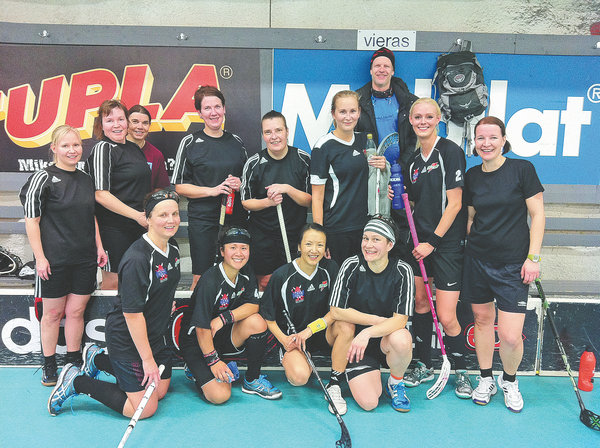
"The teachers' average age was above 45 and there was no professional sports teacher or playground," Chen says, referring to the dearth of sports personnel and facilities experienced by many rural schools.
"Some pupils have to walk to school for as long as an hour, and although they get exercise, some principals don't see the need to introduce new sports," she adds.
A trial game was held in front of Bangzhai's school principal, who was deeply moved by the enthusiasm and joy he saw on the children's faces. The young players used their sticks to chase a small plastic ball, transforming the earthen school grounds into a makeshift court, with two flowerpots serving as goalposts.
Bangzhai became the first primary school of its kind to embrace floorball in rural China. In 2016, Chen made a bold decision to depart from the Shanghai International Studies University after 16 years and started the Vikings Floorball Club, with a focus on training youths and coaches in the basics of the sport.
"Many thought I was crazy for leaving a stable teaching job," she says. "But I wanted to do more."
"We've been exploring ways to engage children in physical activity, especially within limited spaces. Floorball fits the bill as it's suitable for all ages and can be played anywhere, including rural China."
Fu Chuguo, a floorball coach at the Kangshengzhuang Center Primary School in Linqing, East China's Shandong province, says,"Floorball is interesting, fast-paced with less physical confrontation, and requires minimal equipment, making it very suitable for pupils as preparation to ice hockey."
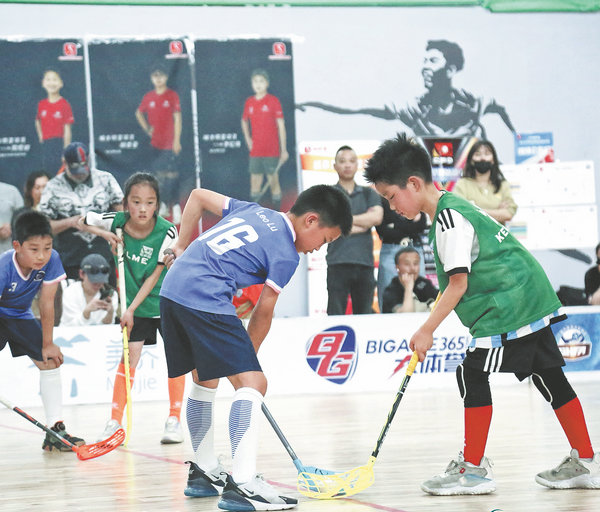
Hu Shengyi, a graduate of the school, played both as a winger and defender and was once the star of the team. She attested to the significant improvement in her stamina since joining the sport. Hu has even traveled with her team to Shanghai for U-Series floorball games, competing with youth teams from major cities.
Many rural students now regularly participate in the U-Series floorball matches in Shanghai, providing them with valuable sports training and exposure to competition in cities.
Over the past two decades, Chen has dedicated herself to promoting floorball across the country. According to data from the Shanghai Floorball Association, Chen and her team have conducted training sessions in almost 200 universities and 2,000 primary schools across at least 28 provinces and municipalities, with many of these primary schools located in rural areas.
"I am also from a rural area. Sports completely transformed my life," Chen says.
As a child, Chen battled severe asthma and was often confined to her bed. Her parents sent her to soccer school, hoping that sports could keep her healthy. Most children growing up in Xiapu of East China's Fujian province were enrolled in soccer, a popular sport in the area.
"It was painful at first and I cried a lot in the training base, which was far away from my home," Chen says.
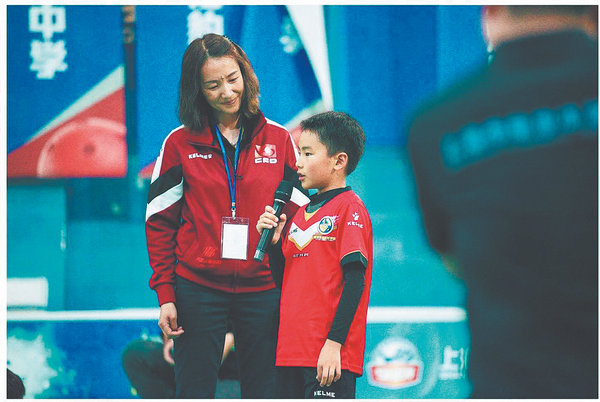
"Sports can give not only good health but also build a brave heart, to face challenges and new things in life," she adds.
Chen then went on to become vice-captain of the Fujian women's soccer team in the 7th National Games in 1993, after which she tried a new sport, taekwondo, and ranked third in an inaugural national-level championship in 1995.
Her luminous career in sports now includes the high point of introducing floorball to students in thousands of schools nationwide.
Time flies, with Chen's identity turning from a young girl playing soccer to strengthen her constitution to a professional athlete, to a university teacher using physical education to help improve others, and now to a promoter of floorball.
"One day, sports will give back to you and tell you everything is possible," she says.
Wu Qiling and Jiang Duo contributed to this story.
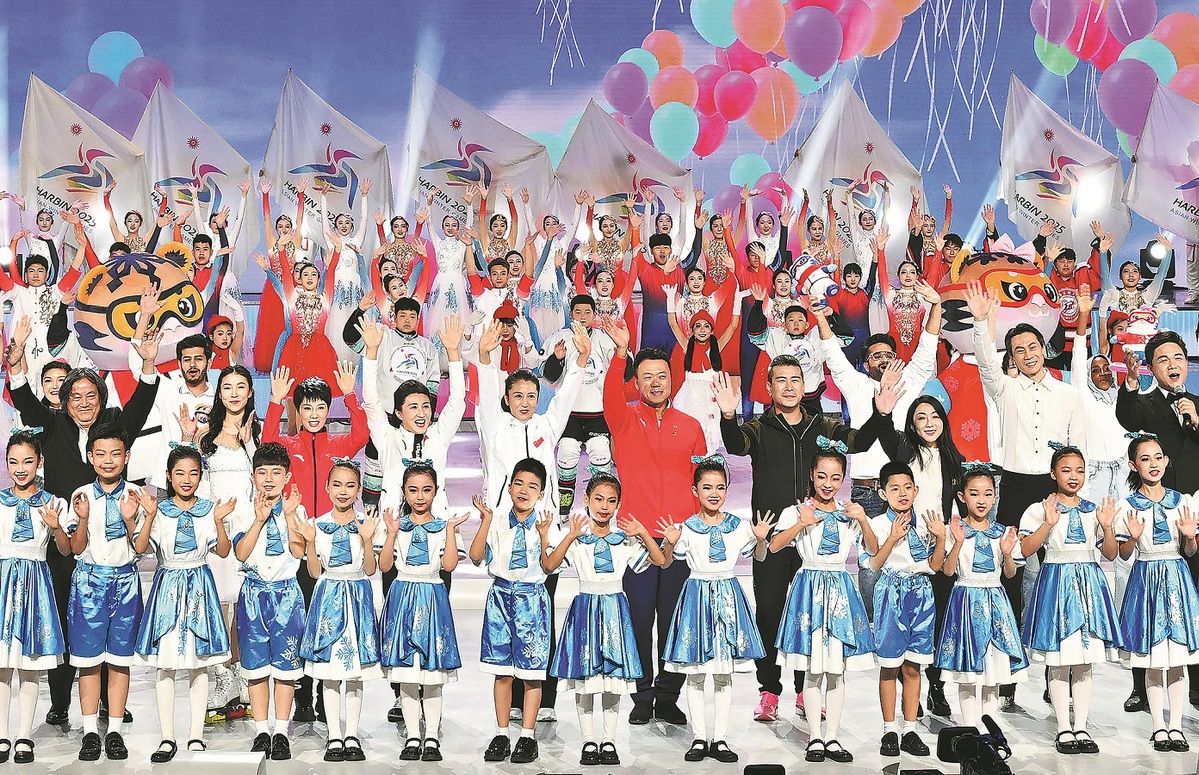
Heilongjiang province and its capital, Harbin, will strive to host a high-level 9th Asian Winter Games, which will help the province create a new growth pole for the ice and snow economy and build a new highland for opening up to the north, the province's governor, Liang Huiling, said on Saturday.
She was addressing residents, athletes, performers, office workers and children gathered in Harbin for a countdown celebration ceremony marking 300 days to the start of the Games, which are scheduled to open in the city on Feb 7 next year.
"Hosting the 9th Asian Winter Games is a glorious mission for Heilongjiang," Liang said. "The 300-day countdown is an important milestone in the preparatory process, marking the crucial stage of accelerating the preparatory work."
Gao Zhidan, head of the General Administration of Sport and chairman of the Games' organizing committee, said the administration will work with Heilongjiang and Harbin to increase the momentum of preparatory work and strive to host a high-level and high-quality Asian Winter Games, showcase the charm of winter sports, promote the vigorous development of ice and snow sports, and improve the level of competition.
"The Games will also provide a platform for exchanges among countries and regions in Asia, and work together with them to create a better future," Gao said.
At the countdown event, a promotional video, Shared Future for Harbin, and the core graphics, color scheme and sports pictograms for the Games were released. The Games will run for eight days and feature six sports, 11 disciplines and 64 events.
Timothy Fok Tsun-ting, vice-president of the Olympic Council of Asia and chairman of its coordination committee, said at the ceremony that the council will continue to promote the beauty and charm of Heilongjiang and Harbin to the 45 member countries and regions.
"We hope that the big family of Asian winter sports will enjoy our own ice and snow event after 300 days," he said.
Preparations in the city are proceeding in an orderly manner, with focuses on environmental protection and technology, the organizing committee said.
The Harbin Ice Hockey Arena will take center stage at the Games after renovation.
"We have selected environmentally friendly decoration materials such as paints and boards, all of which must pass environmental testing before use," said Qin Xulin, director of the engineering department at Harbin Urban Development Investment Group. "Sports lighting equipment will all be energy-efficient, low-consumption devices, and temporary buildings will adopt recyclable modular structures."
In addition to building dedicated information technology networks for events and media at the Games, comprehensive network upgrades are also being carried out in related transportation hubs, expressways, high-speed rail lines and accommodations.
"To meet the needs of spectators, athletes and referees in the venues, we will also extensively utilize tri-carrier aggregation technology and 5G-A technology, providing users with a better wireless internet service experience," said Liu Guoxiang, deputy director of the information technology department of the Harbin Asian Winter Games Executive Committee. "We hope Harbin can showcase to the world the outstanding achievements it has made in driving technological, managerial, service and industrial innovation through digitization, intelligence and networking."
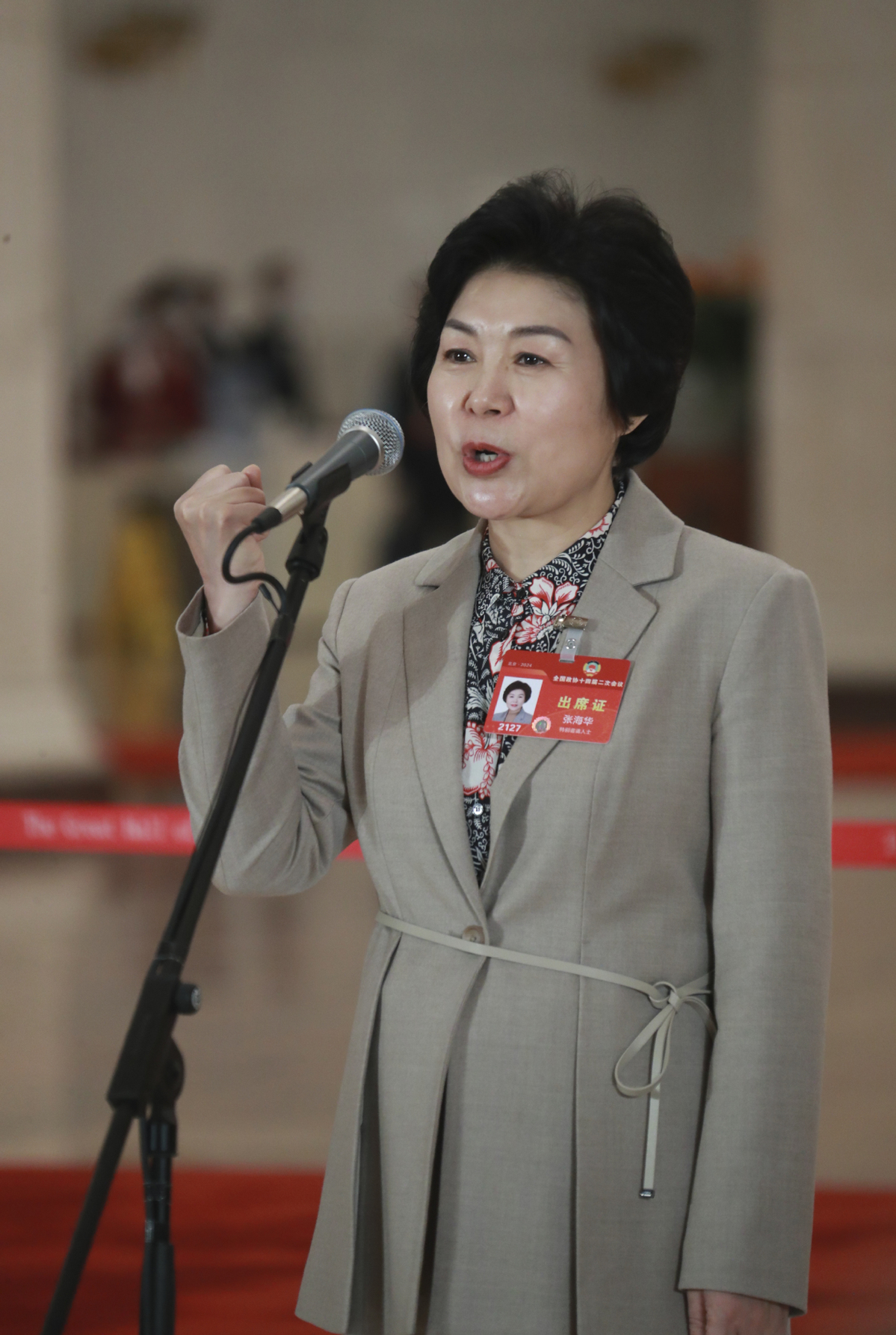
Harbin's booming winter tourism is setting the stage for a strong start to the vitalization of old industrial areas in the new year, said Zhang Haihua, deputy mayor of Harbin, capital of Heilongjiang province, and member of the Chinese People's Political Consultative Conference National Committee, during an interview at the Great Hall of the People in Beijing on Thursday.
"The bustling Harbin Ice-Snow World and crowded Central Street make us deeply feel the warm atmosphere of China's continued economic recovery and improvement," Zhang said.
She emphasized Harbin's commitment to careful work to project a warm and welcoming city image.
The Harbin Polar Park's beloved "Truant Penguin", who is now 7 years old, has become the city's ambassador of urban tourism.
Zhang also said that last winter, young visitors from Taiwan nicknamed "Xiao Danggui" (Little Angelica) experienced the delights of Harbin's ice and snow world. She extended an invitation for them to return during the summer vacation to see the beauty of red-crowned cranes.
With the 9th Asian Winter Games being held in Harbin in 2025, Zhang believes the event will inject fresh energy into the city. She stressed the importance of seizing this opportunity to put into practice the belief that "ice and snow can be treasures" to make Northeast China a hub of comprehensive vitalization through bold action and practical endeavor.
With plentiful natural resources, a robust industrial base, and unique geographical advantages, Northeast China is not only the country's breadbasket, but is also a vital industrial hub, home to key national enterprises, prestigious universities, and research institutions, Zhang said.
"We must leverage these advantages and opportunities, strengthening Northeast China's pivotal role and charting a new path toward high-quality, sustainable development and vitalization," she said.
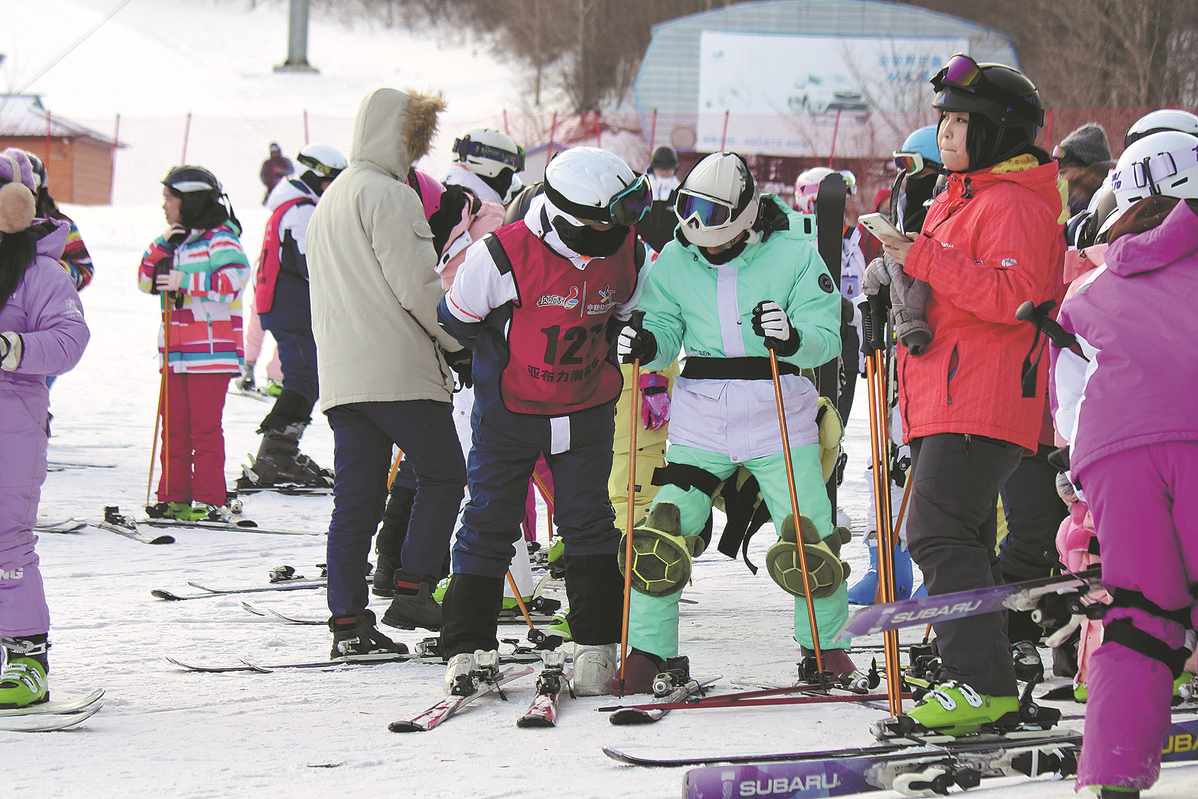
For years, Yabuli, a small town in Northeast China's Heilongjiang province that was unknown to all but those who lived there, luxuriated in splendid isolation. That was the case until 1996, when fame hit and transformed the town.
The instant celebrity came about because that year's Asian Winter Games skiing events were held there. Now the town is preparing for a second brush with history, as it prepares to again stage skiing events for the 9th Asian Winter Games next year.
It is no overstatement to say that the 1996 Asian Winter Games changed the town forever, as Yabuli cashed in on its fame, with Yabuli Ski Resort generating the construction of transformational infrastructure, the improvement of transportation and the creation of jobs.
In fact, Yabuli locals, dragged quickly from geographical obscurity, claimed a key role for themselves in helping to build China's major winter sports industry.
"If we had no winter sports venues in Yabuli, such a remote village would not be linked to the high-speed railway lines," said Sun Jingjing, who, like many of her fellow villagers, saw her life being transformed by major sports events.
The first of those was the Asian Winter Games in 1996, followed by the National Winter Games 12 years later, the same year as the Summer Olympics in Beijing. In 2025, the Asian Games will return.
Sun, who lives at the foot of the Yabuli snowfields, now runs a homestay. The income from that is complemented by what she gets from agricultural work that consists of growing black fungus and picking mushrooms in the mountains. That work is done predominantly during the summer, and during the ski season in winter, Sun welcomes paying guests into her home, which is complete with a restaurant whose menu includes products from her farming.
Another homestay operator is Yu Zhenyou, who is in his 50s and has been in the business since 2019. The farmer from Qingshan village, which is adjacent to the resort, is another villager whose first business venture cashed in on Yabuli's winter tourism.
"The Asian Winter Games have completely changed the destiny of local villagers," Yu said. "Our lives and the work we do are closely linked to the boost in winter sports."
Yabuli, which is 177 kilometers southeast of Heilongjiang's capital, Harbin, is now regarded as one of the country's top ski resorts, and is particularly noted for its ski jumping facilities.
Many other Yabuli locals count the blessings that winter sports have given them.
"Soon after the Asian Winter Games in 1996, a highway was built near our village, and it is precisely because of the resort that the level of our local infrastructure now matches that of a city," Yu said.
Many young residents work as ski instructors around the country, having had an early start in the winter sports sector, Sun said.
Yabuli locals now play a key role in major ski resorts nationwide, providing valuable industry experience, such as operating snow-making machines and helping in the financial management of ski resorts in other provinces and regions.
Heilongjiang expertise has helped train more than 12,000 of the nation's ski and other snow sport instructors, with about 1,500 specialists trained annually, which accounts for one-fourth of the total number in China, said Dong Xiaodong, deputy director-general of the administration of sports of Heilongjiang.
When visiting Heilongjiang in September, President Xi Jinping said the winter economy should be fostered as a new source of growth, promoting the development of sports, culture, equipment and tourism related to ice and snow.
The hosting of the 2022 Winter Olympics has driven the growth of the winter sports industry and the ice and snow economy, and China's goal of involving 300 million people in ice and snow activities has come true, Xi said.
Chen Changpeng, office director of Yabuli Ski Resort, said the resort has hosted about 2,000 tourists a day this winter. Most visitors have come from the Pearl River and Yangtze River delta regions, accounting for about 70 percent of total tourist figures.
The annual report on China's ice and snow tourism development, released by the China Tourism Academy in January, projected that by the end of the 2024-25 ice and snow season, China's ice and snow leisure tourism sector is expected to receive more than 520 million visitors, with its revenue exceeding 720 billion yuan ($100 billion).
With the countdown to the second staging of the Asian Winter Games in Harbin next year, the province is proceeding with an infrastructure extension plan including a tourism railway extending to Yabuli. The extension is expected to be ready at the end of the year, said Shen Haitao, deputy secretary-general of the 9th Asian Winter Games executive committee, during a seminar on the Games and the high-quality development of the ice and snow economy.
"We have formulated a plan for urban infrastructure improvement, including upgrading 163 roads and enhancing the cityscape. We are accelerating the second-phase expansion project of Harbin Taiping International Airport and the expansion of the Yaxue Highway connecting Harbin and Yabuli," Shen said.
Li Ling, an official of the province's culture and tourism department, said the recent trend of tourists from southern China heading in huge numbers to Heilongjiang is unprecedented.
As excitement builds for the Asian Winter Games, Yabuli is also welcoming back many residents who had previously ventured out for work, as young villagers return from other provinces to their hometown to tap growing job opportunities.
"Five of my relatives who worked in the ski industry outside Yabuli in previous years have returned home, bitten by the ski fever," said Sun, the farmer and homestay operator.
Tang Miaofan and Jiang Duo contributed to this story.
Contact the writers at houchenchen@chinadaily.com.cn
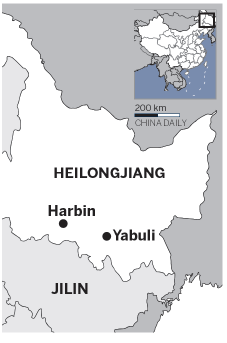
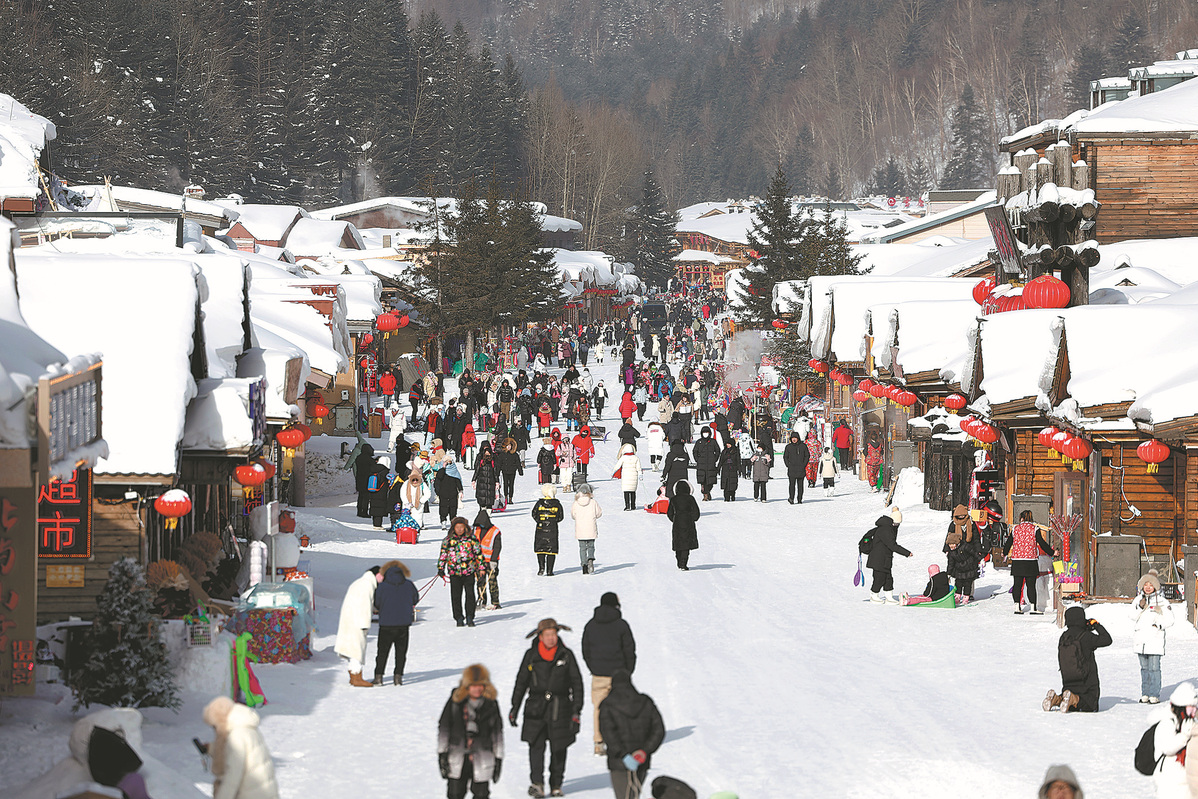
Diplomats and other foreign dignitaries visited Northeast China's Heilongjiang province last week to seek more cooperation projects and share their experiences in related fields, with green opportunities in the winter sports and tourism industry being a focus of their attention.
The visitors, from countries with a strong winter sports culture and member states of the Olympic Council of Asia, also aimed to forge cooperation in the ice-and-snow industry.
For Peter Lizak, Slovakia's ambassador to China, providing suitable heating in the snow-covered area was an impressive achievement witnessed during a trip to Xuexiang National Forest Park in Mudanjiang.
"The air is clear, and I did not smell any coal burning here," Lizak said.
The province, known for its rich coal resources, is also a popular winter tourist destination, with its snow and ice attractions.
Lizak was one of the 22 guests from 18 countries and international organizations who arrived in Mudanjiang on Tuesday as part of a five-day tour, organized by the Foreign Ministry, to gain firsthand insights into the 2025 Asian Winter Games set to be held in Harbin, the capital of Heilongjiang.
The visiting diplomats expressed their keen interest in Heilongjiang's sustainable development in the emerging sector, which attracted many of the 6.62 million tourist visits to the province during the recent three-day New Year's holiday.
"We have to invest in sustainable means of transportation, sustainable ways of managing hotels and sustainable ways of managing infrastructure," Juerg Burri, the Swiss ambassador to China, said at a seminar on the ninth Asian Winter Games and the high-quality development of the ice-and-snow economy.
Burri said it is necessary to develop great infrastructure to develop the winter economy without harming the landscape.
Lizak said: "It is a complicated thing to balance tourism development and environmental protection. In Slovakia, we have restrictions on developing ski resorts in important nature reserves."
The local government has actively worked to protect ice and snow resources and boost the winter tourism economy, said Zhao Wenzheng, an official at Mudanjiang's foreign affairs office.
Zhao highlighted the use of green technology, such as the use of a geothermal heat pump system in local factories.
Traffic restrictions in the snow-covered region and the use of electric cars in freezing temperatures were also topics of interest among the visitors. Private gasoline-powered cars are restricted in snowy areas, and only electric cars and public transportation are permitted in the mountainous tourist spots.
"Electric cars and their batteries in China have developed rapidly, and they can now run smoothly in such winter climates," Zhao said.
Andreas Riecken, the Austrian ambassador to China, said that finding adequate energy for heating in freezing winters remains a challenge for snowy and icy countries.
"The water is frozen and the weather is not sunny, so solar power and hydro power are not reliable," he said.
Austria aims for carbon neutrality by 2040, and China before 2060.The two countries can cooperate more in green energy to achieve these goals, Riecken said.
Milia Jabbour, the Lebanese ambassador to China, said that it was the first time she had visited Heilongjiang and that she found the two countries can certainly share their experiences in the snow tourism industry.
"During this trip, I find we can learn from each other," Jabbour said. "As a new resort, Heilongjiang can learn more from Lebanon and other countries to cultivate culture and identity around snow, to attract tourists to come back again, while Lebanon can learn from Heilongjiang how to develop infrastructure and respect the ecosystem."
During the trip, the bus transporting the guests also took them to a frozen lake, giving them the opportunity to witness how local residents celebrate the winter fishing season.
